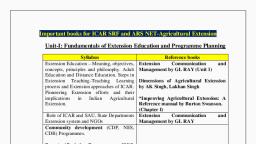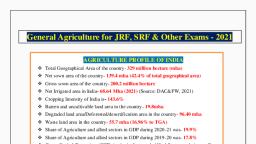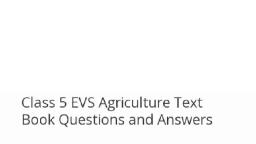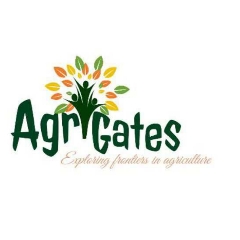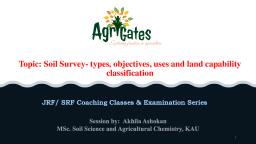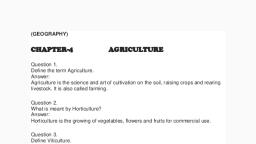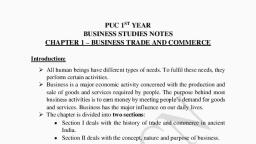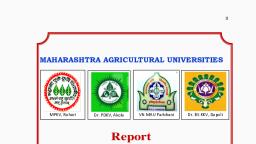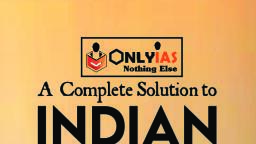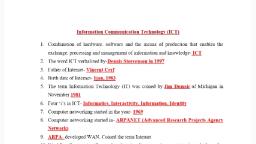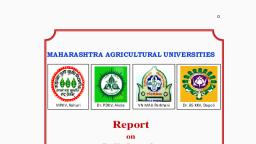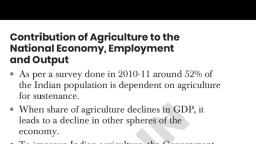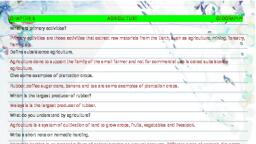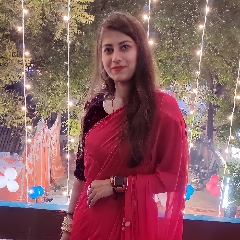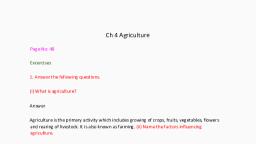Page 1 :
General Agriculture for JRF, SRF & Other Exams - 2021, AGRICULTURE PROFILE OF INDIA, ❖ Total Geographical Area of the country- 329 million hectare (mha), ❖ Net sown area of the country- 139.4 mha (42.4% of total geographical area), ❖ Gross sown area of the country- 200.2 million hectare, ❖ Net Irrigated area in India- 68.64 Mha (2021) (Source: DAC&FW, 2021), ❖ Cropping Intensity of India is- 143.6%, ❖ Barren and uncultivable land area in the country- 19.8mha, ❖ Degraded land area/Deforested/desertification area in the country- 96.40 mha, ❖ Waste land area in the country- 55.7 mha (16.96% to TGA), ❖ Share of Agriculture and allied sectors in GDP during 2020-21 was- 19.9%, ❖ Share of Agriculture and allied sectors in GDP during 2019-20 was- 17.8%, ❖ Gross Capital Formation (GCF) in Agriculture and Allied Sectors relative to Gross, Value Added (GVA) during 2019-20 was- 16.4% (GCF an indicator of level of, investment activity)., ❖ The percentage share of Agricultural workers in Total workers is 54.6%. (Registrar, General of India), ❖ The percentage of rural households is engaged in agriculture-57.8% (Situation Assessment, Survey of Agricultural Households, NSO), , Source: Land Use Statistics & DES 2020-21, ❖ *Total forest cover in India is- 80.73 million ha (24.56% of geographical area), (Source: Indian state of Forest report-2019, released biennially once by Forest Survey of India), ❖ State with highest forest area in the country is- Madhya Pradesh, followed by Arunachal, Pradesh, ❖ Top five states with forest cover as percentage of total geographical area is- Mizoram, (85.41%), Arunachal Pradesh (79.63%), Meghalaya (76.33%), Manipur (75.46%) and, Nagaland (75.31%)., ❖ For maintaining ecological balance percentage of the land area should be under forest is-33, ❖ The per capita forest land availability in the country is - 0.08 hectare (normal requirement for, basic needs is 0.47 hectare), ❖ Total bamboo bearing area of the country is- 16 Million hectare (Mha), ❖ The total food grain production in India for the year 2019-20 was- 296.65 million tonnes, , Prepared by r@f@ Extn# ANGRAU
Page 2 :
❖ Net Irrigated area in India - 68.64 Mha (2021) (Source: DAC&FW, 2021), (Note: Net Irrigated area includes irrigating by government canals, private canals, tanks, tube, wells, other wells)., ❖ Gross irrigated area of India is- 96.46 Mha, ❖ The state with highest net irrigated area is- Uttar Pradesh (14.33 Mha), ❖ *Total Micro irrigation area in India is- 12.90 Mha (Drip= 6.11 Mha; Sprinkler= 6.79 Mha), Note: Only 19% of out of total irrigated area is under micro-irrigation., ❖ State with highest Micro irrigation area is- Andhra Pradesh (1.9 Mha), ❖ State with highest area under Drip irrigation is- Andhra Pradesh (1.38 Mha), ❖ State with highest area under Sprinkler irrigation is- Karnataka (1.14 Mha), ❖ State with highest area under micro irrigation when compared with total net irrigated area isSikkim (73%), ❖ Contribution of Livestock to National GDP is- 5.2% (2020-21), ❖ The contribution of livestock in total agriculture and allied sector GVA (at constant prices)/GDP, is- 28.63 per cent, ❖ Growth rate of GVA of Agriculture and Allied sectors at basic prices in 2019-20 is- 4.0%, ❖ Overall growth rate of GVA at Basic Prices is- 3.9%, ❖ Overall GDP growth rate at Constant Prices (2011-12) in 2019-20 is- 4.2 %, ❖ The United Nations General Assembly has declared 2020 as the- International Year of Plant, Health, ❖ *The United Nations General Assembly has declared 2021 as the- International Year of Fruits, and Vegetables, ❖ The United Nations General Assembly has declared 2022 as the- International Year of, Artisanal Fisheries and Aquaculture, ❖ The United Nations General Assembly adopted a resolution sponsored by India and declaring, 2023 as the International Year of Millets, Note: India is the largest producer of Millets in world, producing 14 million tonnes in 14, Mha and accounts for 40 percent of the world’s output, ❖ UN decade of action of nutrition -2016-2025, ❖ India’s 1st pollinator park with over 40 species of butterflies, honeybees, birds and other insects, set up at- Haldwani in Nainital district of Uttarakhand on 29 December, 2020., , ❖ Multipurpose sea weed park to be established at- Tamil Nadu, , (To promote seaweed, , cultivation, as it is an emerging sector with potential to transform the lives of coastal, communities)., , Prepared by r@f@ Extn# ANGRAU
Page 3 :
❖ The ambitious targets set by government of India for renewable energy capacity addition by, 2022 is- 175 Giga watts (GW), Note: Out of 175 GW- 100 GW for Solar, 60 GW for Wind, 10 GW for Bio-energy and 5 GW for, Small hydro-power., ❖ The state with highest installed solar power generation capacity in India is- Karnataka (Installed, 7,100 megawatt (MW) solar capacity., ❖ A National level Ag-tech Hackathon for promoting innovation in farm mechanizationKRITAGYA (Launched by ICAR-NAHEP), ❖ India's first convergence green energy project to generate green energy for rural and, agriculture consumption to be set up in- Goa (Nov, 2020), ❖ World’s largest solar tree installed at- Durgapur, West Bengal, ❖ The United Nations General Assembly (UNGA) proclaimed 2021-2030 as- UN decade of, ecosystem restoration and oceanic science for sustainable development, ❖ *Mobile App launched by CSIR-CRRI (Central Road Research Institute, New Delhi) to, connect farmers to Supply chain is- Kisan Sabha, 2nd May, 2020, ❖ App launched by Prime Minister of India for comprehensive breed improvement market, place and information portal for direct use of livestock farmers is- e-Gopala (Sep 9, 2020), ❖ Largest exporter of Rice in the world is- Indias, Note: India becomes a largest exporter of rice in the world with record of 14 million tonnes of, rice export in 2020., ❖ *The first state in the country to flagged off India’s First fruit train was- Andhra Pradesh, Note: A fruit train was flagged from Tadipatri railway station in A.P. carrying a load of 980, metric tonnes of locally grown bananas to Jawaharlal lal Nehru Port in Mumbai from where the, consignment will be exported to Iran (Bananas exported under brand name Happy Bananas), ❖ **The Asian development bank and Govt. of India signed a 10 million Project Readiness, Financing to expand horticulture and to promote Instant Quick Freezing of fruits and vegetables, in which state- Himachal Pradesh, ❖ *India’s First Kisan special Parcel Train or Kisan Rail transported fruits and vegetables, between- Maharastra (Devlali) and Bihar (Danapur) (three days in a week), ❖ India’s First ever Kisan Rail for seamless connectivity among farms, markets & consumers was, flagged off on- 7th August, 2020, ❖ India’s second and South India’s first Kisan train run between- Anantapur (Andhra, Pradesh) and New Delhi., ❖ India’s second Kisan train started on- 9th Sep 2020, , Prepared by r@f@ Extn# ANGRAU
Page 4 :
❖ *Ministry of Agriculture and Farmer’s Welfare launched ‘All India Agri Transport Call, Centre’ number to facilitate interstate movement of perishables is- 1800 180 4200 and 14488, ❖ *Central Government recently approved field trials of Indigenous Bt Brinjal VarietiesJanak and BSS-793 (Developed by IARI contains Bt Cry1Fa1 gene) (IMP), ❖ The first Indian state to declare state mangrove tree as symbol of conservation isMaharashtra, Note: Maharashtra State board for wild life cleared a proposal to declare “Sonneratia alba” as, the state mangrove tree., ❖ India’s 1st cow dung paint developed by Khadi Village Industries Commission (KVIC) India isKhadi Prakritik paint on 13th Jan, 2021., Note: Khadi prakritik paint prepared from cow dung as its main ingredient, the paint is cost, effective and odourless and has been certified by BIS., ❖ *India’s first honey testing laboratory set up at- NDDB, Anand, Gujarath (24 July, 2020)., Note: Lab set up as per Norms of FSSAI. Purity of Honey, Adulteration, chemical substances,, Residues, Heavy metals or antibodies can be checked., ❖ India's first solar “agro-photovoltaic” power project will be set up on a 250-acre area inPampore, Jammu and Kashmir (generate up to 10 megawatts of electricity and simultaneously, used for saffron production), ❖ Prime Minister of India launched Asia’s Largest Solar plant (750 MW) in- Rewa, Madhya, Pradesh (10 July 2020), ❖ India’s biggest floating solar power plant with a capacity of 100 MW will be set up atRamagundam in Telangana., ❖ *How much economic relief package is announced by Prime Minister through Atma, Nirbhar Bharat Abhiyan- Rs.20 Lakh crore, ❖ **Atma Nirbhar Bharat Abhiyan economic package is equivalent to how much of India’s, GDP- 10%, ❖ Financing facility provided for Agriculture Infrastructure Fund for agri-entrepreneurs,, start ups and farmer groups is- 1 Lakh crore, ❖ National Medicinal Plants Board located at- New Delhi (Under Ministry of AYUSH), ❖ Online registration portal developed by National Bee Board under National Beekeeping &, Honey Mission (NBHM) to achieve a traceability source of Honey and checking source and the, quality and source of adulteration of honey- Madhurkranti Portal (7 April 2021)., ❖ A special spaces for the marketing and sale of honey launched and operated by NAFED isHoney corners 7 April 2021), ❖ Electronic trading platform launched by NAFED with physical infrastructure present at each, proposed location in partnership with local FPO to be integrated with a national level digital, , Prepared by r@f@ Extn# ANGRAU
Page 5 :
marketing platform is- NAFED e-Kisan Mandis (NeKM), ❖ India’s largest semen station in Government sector launched at- Purnia, Bihar (Sep 9, 2020), ❖ *ICAR-IASRI cloud infrastructure and services for National Agricultural Research, Education system is- Krishi Megh at New Delhi (11 Aug 2020), , &, , ❖ Data recovery centre of ICAR was- Krishi Megh, Note: For Protecting Data of the ICAR., ❖ *Mobile App launched by Ministry of Agriculture and Farmers Welfare to facilitate farmers and, traders to identify right mode of transportation for movement of farm produce is- Kisan, Rath, 17th April 2020. (Developed by National Informatics Center (NIC), Note: Primary Transport - From Mandi to Mandis, FPOs, Warehouses;, Secondary Transport- Mandis to intra-state and inter-state mandis, railway stations., ❖ The first country in the world to adopt a ban on deforestation, a groundbreaking move that, could have a major global impact is- Norway on 28 Jan, 2020, ❖ *India’s first ever brand logo for cotton and India’s premier cotton would be known as- Kasturi, Cotton, ❖ World's largest commercial agriculture drone/World’s most advanced drone for agriculture- Air, board agro (founded by Elviss Straupenieks of Latvia), ❖ The target of renewable energy capacity kept by Govt. of India for 2030 is- 450 GW, ❖ The first farm-based solar power plant under the PM KUSUM (Kisan Urja Suraksha Evum, Utthan Mahabhiyan) scheme has come up in- Jaipur district's Kotputli tehsil with a provision for, production of 17 lakh units of electricity every year (April 2021)., ❖ KVIC prepared Nutrient rich healthy drink/processed drink- ‘Neera’ and Palmgur (jaggery), from Palm oil, ❖ India’s first agricultural futures trading index ‘Agridex’ with four contracts expiring in June,, July, September and December was launched by- National Commodity and Derivatives, Exchange (NCDEX), Note: Agridex, launched on 25 May, 2021, comprises 10 liquid commodities traded on NCDEX., The spot and future of these 10 commodities- soybean, chana, coriander, cottonseed oilcake, guar, gum, guar seed, mustard seed, refined soy oil, castor seed and jeera., ❖ World’s First conversation area for sea cucumber created at- Lakshadweep, ❖ *------- becomes the first state under Pradhan Mantri Fasal Bhima Yojana (PMFBY) to cover crop, loss done by wild animals- Sikkim, ❖ India’s first Gender Park set up at-Kozhikode, Kerala on 11-13 February, 2021 (on the occasion, of Second Edition of International conference on Gender Equality)., , Prepared by r@f@ Extn# ANGRAU
Page 6 :
Note: Gender Park was established with the aim of creating relevant interventions so as to address, a range of gender based issues., ❖ *India’s first wetland conservation centre/ first specialized institution for wetlands ‘Centre for, Wetland Conservation and Management (CWCM)’ established in- Chennai on 2nd Feb 2021., Note: India has 42 sites designated as wetlands of international importance under Ramsar, convention, covering a surface area of 1.08 mha., ❖ National Research Centre for Chikoo/Sapota set up in- Thane, Maharashtra, ❖ Which state forest department has done census of water birds for the first time- Uttar, Pradesh, ❖ Union ministry of Agriculture launched Green- Ag. Project to reduce emissions from agriculture, and ensure sustainable agricultural practices on pilot basis in- Mizoram (28 July, 2020), Funded by: Global Environment Facility; National Execution Agency- Ministry of Agriculture., ❖ Power house of Nutrients/Nutri-Cereals/Climate resilient crops are- Millets, ❖ *Rural Retail Outlets opened by Indian Oil Corporation Limited to provide rural customers, with facilities like Micro ATM, Fertilizers/Pesticides, farm equipments is- Kisan Seva Kendra, (KSK operating in the country is 8044, functioning under Min. of petroleum & Natural Gas), ❖ *Total number of KVKs at present is- 722 (as of June, 2020), ❖ For effective functioning and monitoring of KVKs, KVKs are divided into- 11 ATARI Zones, ❖ Country's first ever electric tractor tested atInstitute (CFMTTI), Budni, M.P. (Feb, 2021), , Central Farm Machinery Training & testing, , ❖ Percentage of Farm mechanization utilization in India is about-40%, ❖ Total food grain production in the country for the year 2019-20 was- 296.7 million tone, ❖ Note: India’s share in global total food grain production is 25%, ❖ Target food grain production set up by government of India for the year 2021-22 is- 307 million, tonnes, ❖ Growth rate of GVA of Agriculture and Allied sectors at basic prices in 2019-20 is- 4.0%, ❖ Estimated growth rate of Agriculture and Allied sectors at basic prices in 2020-21 is- 3.4% (1st, Advanced Estimates), ❖ Share of Agriculture and allied sectors in GDP/GVA during 2019-20 was- 17.8%, Item, Share in GVA (2019-20), Crops, , Prepared by r@f@ Extn# ANGRAU, , 9.4
Page 7 :
Livestock, , 5.1, , Forestry and Logging, , 1.3, , Fishing and Aquaculture, , 1.2, , Note: Gross Value Added is simply gross domestic product minus taxes, the widest measure of, income growth in an economy., (Source: Economic Survey 2020-21)., ❖ Sub-Sectoral, , contribution, , in, , total, , GVA, , of, , Agriculture, , &, , Allied, , Sector-2019-20, , Contribution of subsectors, to Agricultural GVA:, ❖, ❖, ❖, ❖, , Crops- 56%, Livestock- 29%, Forestry and Logging-8%, Fishing & Aquaculture-7%, , ❖ *Total Pulse production for the year 2019-20 is- 23.03 MT, ❖ *The unique project launched by KVIC to mitigate human-elephant conflicts in the country isRE-HAB (Reducing Elephant Human Attacks using Bees), Note: Sub mission under KVIC’s National Honey mission. To mitigate human elephant, conflicts by creating ‘bee-fences’., ❖ Among Pulses the crop with highest production and largest area under cultivation is- Bengal gram/, Chick pea/Chana/gram (Second is Arhar/Pigeon pea), ❖ Among Oil seeds the crop with highest production and largest area under cultivation isSoyabean(Second is Groundnut), ❖ International Rice Research Institute (IRRI) South Asia Regional Centre established atVaranasi, U.P. (Dec, 2018), ❖ First Director of IRRI South Asia Regional Center- Dr. Arvind Kumar, ❖ The buffer stock maintained/Procurement made by FCI is- 81.66MT (Rice-26.62 MT; Wheat55.03 MT) as of July 2020, ❖ Note: Normal buffer stock capacity of FCI is- 41.12 mmt, ❖ Rice Knowledge bank launched (an agriculture web portal) launched on- 28 Feb, 2019 at Assam., Funded by World Bank for enhancing knowledge on Rice production techniques and technologies., ❖ Farm Science congress held for the first time in- Bengaluru, Jan 3, 2020, ❖ The Programme launched by Prime Minister for eradicating the Foot and Mouth Disease (FMD) and, Prepared by r@f@ Extn# ANGRAU
Page 8 :
❖, ❖, , ❖, , ❖, , ❖, , ❖, ❖, ❖, ❖, , ❖, , Brucellosis in the livestock is - National Animal Disease Control Programme (NADCP), 11 Sep,, 2019., The main aim of NADCP is- to control Foot & Mouth Disease (Viral Disease) of cattle and, Brucellosis (Zoonotic disease caused by bacteria) by 2025 and eventual eradication by 2030., World Bank assisted project SMART launched by which state to Augment agribusiness in rural, areas is- Maharashtra. SMART-State of Maharashtra’s Agribusiness and Rural, Transformation (SMART), Government of India set up a target of 20% ethanol blended petrol by- 2025, Note: India is the third biggest emitter of greenhouse gases after the US and China and plans to, reduce its carbon footprint from the 2005 levels by 33-35% by 2030 and pushing ethanol production, from surplus sugar production., Union Ministry of Agriculture and Farmers Welfare launched online software for processing, applications, Agmark quality certification mark for agricultural products is- AGMARK Online, system, Monthly pension scheme launched by Central govt. for benefit of Small & marginal is- Pradhan, Mantri Kisan Man Dhan Yojana (Sep 12 2019); Monthly Pension of Rs.3000 will be provided to, farmers on attaining the age of 60 Yrs., India’s first high oleic acid groundnut varieties developed by ICAR-DGR, Junagadh is- Girnar, 4(ICGV 15083) & Girnar 5 (ICGV 15090), First SAARC Agri Cooperative Business Forum held in- 28-30 August, 2018 at Kathmandu,, Nepal., Khadi and Village Industries Commission (KVIC) has opened its first Silk processing plant atSurendranagar, Gujarat, **The World Food Prize 2021 was awarded to- Dr. Shakuntala Haraksingh Thilsted (Note:, Haraksingh Thilsted from Trinidad and Tobago, for her groundbreaking research in fish, based food systems to improve nutrition, health and livelihoods for millions around the world)., (M. Imp), The total egg production in the country during 2019-20 was- 114.38 billion, , ❖ According to FAOSTAT production data (2019) India rank in egg production in 2019-20 was- 3rd, ❖ The per capita availability of egg in 2019-20 was- 86 eggs per annum, ❖ Total Meat production in the country in 2019-20 was- 8.6 million tonnes, ❖ India rank in meat production in the world was- 5th, ❖ Per capita availability of eggs in India is- 74 per person per year, ❖ Position of India in terms of Egg Production- 3rd (1-China; 2- USA), ❖ Total commercial poultry population in India was- 534.7 Million, ❖ *Total Milk production in the country during 2019-20 was- 198.4 million tones, ❖ Per capita availability of Milk in India- 407 grams per person per day, ❖ The estimated demand for Milk and Milk products by 2030 at an all India level is- 266.5 million, , Prepared by r@f@ Extn# ANGRAU
Page 9 :
metric tones, ❖ The per capita consumption of milk in the urban areas is- 592 ml and in the rural areas is- 404 ml, (2030 projections), ❖ ***India’s share in World Milk production- 21%, ❖ Minimum Support Price recommended by– Commission for Agricultural Cost and Prices, (CACP), ❖ MSP announced by- Government of India; MSP is calculated based on Avg. Cost of Productio, Note: MSP was first announced for Wheat crop in the year 1966-67, ❖ **At present MSP is announced for- 23 crop commodities only, Note: 7 cereals (paddy, wheat, maize, sorghum, pearl millet, barley and ragi), 5 pulses (gram, tur,, moong, urad, lentil), 7 oilseeds (groundnut, rapeseed-mustard, soyabean, seasmum, sunflower,, safflower, niger seed), and 4 commercial crops (copra, sugarcane, cotton and raw jute)., ❖ *The state that produces highest food grains is- Uttar Pradesh, ❖ *The State that produces highest Pulses is- Madhya Pradesh, ❖ The state that ranks first in Oilseed production is- Rajasthan, ❖ 2018- National year of Millets, ❖ **The First Ever world Pulse Celebrated on-10 Feb,2019, ❖ **First ever World cotton day celebrated on-, , 7th Ocober, 2019, , ❖ First ever World Food Safety Day celebrated on- 7th June, 2019, ❖ FAO of the UN declared the annual observance of World Pulses day starting from the year-2019, ❖ WTO hosted First Edition of World cotton Day on 7 October in- Geneva, Switzerland, ❖ Institutional credit for Agriculture sector for the year 2021-22-16.5 lakh crores, ❖ Time period for achieving Sustainable Development Goals (SDG) set up by UN is- 2015-2030, ❖ Number of Sustainable Development goals- 17, ❖ Main aim of Sustainable Development Goals laid by the United Nations is - to ensure food security, vis-à-vis nutritional security, ❖ Chairman of 15th Finance Commission (2017-2022) was- NK Singh, ❖ Chairman of International Egg Commission (IEC)- Suresh Chitturi, ❖ Chairman of the Asia Pacific Rural and Agricultural Credit Association (APRACA)- Chinta, Govindarajulu, ❖ Total number of regulated markets in India- 7320, , Prepared by r@f@ Extn# ANGRAU
Page 10 :
❖ Total number of APMCs (Agricultural Produce Market Committees)- 585, ❖ Total number of GRAMs (Gramin Retail Agriculture Markets)-22,000, ❖ ** The first state to enact law on Contract Farming in India is- Tamil Nadu, ❖ *The First state in the country to implement “Land Leasing Policy” – Uttarakhand, ❖ “Agricultural Produce and Livestock Marketing” (Promotion & Facilitation) Act was enacted in, the year- 2017, ❖ Govt. of India Constituted Agri export policy for farmers on -9 Dec, 2018 (aim: to double Agri, exports to 60 billion$ by 2022), ❖ Note: APEDA Nodal agency for implementing Agri Export Policy., , Important Policies/Acts/Ordinances:, Policy/Act, Land Leasing Act, , Agriculture Produce & Livestock, Marketing Act, , *Contract Farming Act/Model, Contract Farming bill, Agri Export Policy, Pesticide management Bill, , The Farmers (Empowerment and, Protection) Agreement on Price, Assurance &, Farm, Services, Ordinance, The Farmers Produce Trade and, Commerce, (Promotion, and, Facilitation) Ordinance, Amendment, to, Commodities Act, , Essential, , Prepared by r@f@ Extn# ANGRAU, , Year of, Purpose, Formulation, 2016, To permit and facilitate leasing of, agricultural land to improve access, to land by the landless and marginal, farmers., 2017, To create a, single, agriculture, market with a single license in which, agriculture produce and livestock would, be traded. There are no separate fees, allocated for individual markets, 2018, To provide adequate confidence to, farmers and incentives to sponsors to, enter into contract farming., 2018, To double Agri exports to 60 billion$, by 2022, 2020, Regulate the business of pesticides and, compensate farmers in case of losses, from the use of agro chemicals., 17 Sep, Government to form and Promote, 2020, 10,000 new FPOs and to promote, (Passed in Contract Farming, parliament), To remove barriers in inter-state, 17 Sep, trade and give farmers the choice of, 2020, sale., 17 Sep, 2020, (Passed in, parliament), , ▪ Deregulation of cereals, edible oils,, oilseeds, pulses, onions and potato, from essential commodities., ▪ Stock limit imposed under exceptional
Page 11 :
situations like natural calamities., ▪ No stock limit for processors, value, chain participants or exporters., ❖ India’s First Agro met Forecast Centre Inaugurated at- UAS, Dharwad, Karnataka., (Main objective is to give accurate reports on weather which would enable the farmers to protect the, crops and get a good yield.), ❖ First state in India to use Automated Weather Stations (AWS) to provide accurate report on, Weather to farmers is- Maharashtra, ❖ Special Micro credit facility scheme to facilitate street vendors to access affordable working capital, loan of Rs.10,000 is- PM SVANIDHI, ❖ Nodal Agency that deals in Procurement, Processing, Distribution, export & import of selected agricultural, commodities- NAFED (Oct, 1958), ❖ Nodal agency for undertaking price support operations for pulses & oilseeds and market intervention operation, for other agricultural commodities is- NAFED, , ❖ Nodal agency for procurement, storage and distribution of food grains is- FCI, Procurement Agencies:, • Wheat & Rice, • Oilseeds & Pulses, • Cotton, • Jute, , FCI, NAFED, CCI, JCI, , ❖ Implementing agency for National Programme for Organic Production (NPOP)- APEDA, ❖ Nodal Agency for Promoting export-oriented production and development of the Scheduled, products- APEDA (1985), ❖ In January 2020 the states that faced severe attack by Locusts is- Gujarat & Rajasthan (5.66, lakh ha area in 10 states (severe in Rajasthan and Gujarat), ❖ *First Pashu Kisan Credit cards were distributed to 101 animal farmers in the state ofBhiwanai , Haryana (Imp), ❖ To provide Digital mobile extension services for coffee stakeholders, Union Ministry of, Commerce & Industry launched- Coffee Connect & Coffee Krishi tharanga, ❖ 22 products received Geographical Indication (GI) tag from Government of India in 2020., Note: The First Product to get a GI Tag in India was- Darjeeling Tea in 2004, The Office of the Controller General of Patents, Designs and Trade Marks (CGPDTM), a, subordinate office under the Department of Industrial Policy and Promotion looks into the filings of, various Intellectual Property rights in India., ❖ National Sugar Institute (NSI) of India will establish Sugar Institute at- Nigeria, , Prepared by r@f@ Extn# ANGRAU
Page 12 :
❖ 5th Pulses conclave held at- Lonovala, Maharsatra, 12-14 Feb, 2020., ❖ The Scheme launched by FSSAI on the eve of World Food Day, 2019 is- Food Safety Mitra, Note: Food Safety Mitra is an individual professional certified by FSSAI who assists in, compliances related to FSSAI act., ❖ The main aim or objective of Food Safety Mitra is- for Strengthening and scaling up ‘Eat Right, India’ movement, ❖ An initiative launched by FSSAI for collection and conversion of used cooking oil to biodiesel isRepurpose Used Cooking Oil (RUCO), ❖ Headquarter of International Solar Alliance- Gurugram, Haryana, ❖ National Nutrition Mission launched on - 8 March, 2018, ❖ National Beekeeping and Honey Mission launched on- 2020 (as part of Atmanirbhar package), Aim: For overall promotion and development of scientific beekeeping in mission mode to, achieve the goal of “Sweet Revolution”., ❖ Target kept by Government of India to become free of Trans fat is - 2022, , *Agriculture Census: 2015, ❖ Total number of Operational Holdings in India -146.45 million, ❖ *Average Land Holding size is- 1.08 hectare (The average size of operational holdings is highest in, Nagaland (5 hectares) and lowest in Kerala (0.18 hectares). (Imp), ❖ Gross Cropped Area in India - 198.36 million ha, ❖ Net Sown Area in India- 140.82 Mha (48% of total area), ❖ Percentage of population depending on agriculture for their livelihood is- 54%, ❖ Percentage of workforce depend on agriculture is- 50%, ❖ Gross Irrigated area in India is- 96.46 Mha (29% of total cultivated area), ❖ Net Irrigated area in India is- 68.38 Mha (20% of total irrigated area), ❖ Maximum number of operational (landholdings) holdings are in- U.P. (23.82 million), ❖ Minimum number of operational (landholdings) holdings are in- Sikkim (72,000), ❖ Percentage of Small and marginal landholdings (below 2 hectares) constituted is- 86.21%, ❖ Percentage of rural women depend on agriculture for their livelihood - 84%, ❖ Percentage of women landholders (Cultivators) in agriculture is- 13.87%, ❖ Agricultural census conducted for every 5years, first Ag. Census conducted in- 1970-71, , Indian Food Processing Sector at a glance:, ❖ Total number of Mega Food Parks in India- 42, ❖ Cold storage capacity of Mega food parks- 32 Mt, ❖ India’s First Aqua Mega Food Park established at- Bhimavaram mandal of West Godavari, Andhra, Pradesh. (14 Feb, 2019), , ❖ Minimum Land required for setting up a Mega Food Park is- 50 acres, Prepared by r@f@ Extn# ANGRAU
Page 13 :
❖ The Food Processing Industry contribution to Agricultural sector is - 9%, ❖ The Food Processing Industry contribution to Manufacturing sector is - 11%, ❖ Post-harvest losses in cereals and Pulses accounts for- 4-6 per cent, ❖ Post-harvest losses in vegetables accounts for- 7-12 per cent, ❖ Post-harvest losses in fruits accounts for- 6-18 per cent, ❖ First Modern Mega Food park set up in NE-states at- Zoram, Mizoram (22 July, 2020), ❖ Italy launched First ever mega food park processing in India pilot project named as ‘The Mega Food, Park’ at- Fanidhar in the Mehsana district of Gujarat. (19 April 2021), , Schemes Regarding Food Processing Sector:, A. Gram Samridhi Yojana: 1 March, 2019., ▪ Launched by: World Bank + Central Govt., ▪ Objective: “To help Unorganized Food processing sector” concentrated in rural areas., ▪ Funding: Rs.3,000 crore (1500 Cr by World Bank, 1000 Cr by Central Govt. and 500 cr by, State Govt.), B. Pradhan Mantra Kisan SAMPADA Yojana- May, 2017, ▪ SAMPADA: Scheme for Agro Marine Processing and Development of Agro processing Clusters, ▪ Objective: Holistic development of the food processing sector (i.e., Mega food parks,, Creation/expansion of preservation facilities, cold chain & operation green)., C. Trifood project : 20 August, 2020, ▪ Launched by: Ministry of Tribal affairs and Ministry of Food Processing, ▪ Implemented by: TRIFED (Tribal Cooperative Marketing Development Federation of India), ▪ Objective: To enhance the income of tribal’s through better utilization of and value addition to, the minor forest produce (MFP) collected by the tribal forest gatherers., Production Linked Incentive Scheme for Food Processing Industry (PLISFPI): May, 2021, ▪ Funding: 10900 Cr, ▪ Objective: to support creation of global food manufacturing champions commensurate with, India’s natural resource endowment and support Indian brands of food products in the, international markets., MITRA- Mega Investment Textiles Parks (MITRA)- February 2021, ▪ Objective: To make the textile industry to become globally competitive, attract large, investments and boost exports., ▪ Target: to establish 7 textile parks over 3Years., E. *Pradhan Mantri Formalisation of Micro Food Processing Enterprises (PM FME): June 2020, ▪ Funding: 10,000 Cr, ▪ Objective: Scheme to help 2lakh MFEs to attain FSSAI Food standards, build brands and, D., , Prepared by r@f@ Extn# ANGRAU
Page 14 :
Marketing., ▪ Implemented in ‘Cluster Based Approach’., , Other Important Snippets, th, , ❖ Target year fixed by Govt. of India for Doubling of Farmers Income is- 2022 (75, Independence of India) (Announced by PM in 2016)., ❖ Chairman of the Committee on Doubling of Farmer Income (DFI)- Ashok Dalwai, ❖ Govt. of India formulated point strategy to double farmers income- Seven point strategy, , ❖ All agricultural programs and policies shift their focus from- Production oriented to Income, oriented approach, ❖ Number of Insecticides/pesticides registered in India (as of Dec. 2020) is- 292 (out of 292 104, are indigenously produced or used in India, Note: India is the fourth-largest producer of pesticides in the world. Among crops paddy accounts, for the maximum share of pesticide consumption (26-28%), followed by cotton (18-20%)., ❖ RKVY (Rashtriya Krishi Vikas Yojana)- renamed as- Remunerative Approaches for, Agriculture and Allied sector Rejuvenation (RAFTAAR) (Time period: 2017-2020), ❖ **To Incentivize states to increase allocation for agriculture and allied sector is the main, objective of- RKVY, ❖ India’s First RRBs to launch digital savings account facility is- Telangana Grameena Bank and, Andhra Pradesh Grameena Vikas Bank, ❖ Country's, , first indigenously developed value added fertilizer is- Neem Coated Urea, , (Enhances Nitrogen Use efficiency and farmers need to apply 10% less urea), ❖ 100% FDI is allowed in- Cold storage, ware houses and Food Processing sector, ❖ Govt. of India has increased MSP of Kharif crops by- 1.5 times of cost of production, ❖ The average size of land holding in India is- 1.08 ha (The average size of operational holdings is, highest in Nagaland (5 hectares) and lowest in Kerala (0.18 hectares)., ❖ Total number of operational holdings in the country according to 2015-16 Ag. census is- 146, Million, ❖ Nodal Agency to coordinate the efforts on the Agri-export zones- APEDA, , Prepared by r@f@ Extn# ANGRAU
Page 15 :
❖ Total no. of Agri Export Zones in India -60, ❖ _______is the key approach for doubling farmers income by 2022- Integrated farming, System (IFS), ❖ Total number of Integrated Farming System (IFS) models developed by ICAR which are, location specific, cost effective, eco-friendly, socially in farmers’ participatory mode was- 63, ❖ Total number of Mega food parks in India- 42 (Operational Mega Food Parks- 17), ❖ A mission launched by Ministry of earth science and technology dedicated to spreading awareness, about nutrition and accessible to all locally available nutritious food, fruits, and vegetables isAahaar Kranti (14 April 2021), ❖ Agricultural Mechanization for Insitu management of crop residue in- Punjab, Haryana, UP,, Delhi., ❖ **A Machine developed by PAU, Ludhiana that allows a farmer to harvest Paddy & plant, Wheat without delay is- Combo Happy Weeder, ❖ NAFED procures “Oilseeds and Pulses” from state government at MSP through- Price, Support Scheme (PSS), ❖ Portal launched by central government of India for e-marketing of Organic products isJaivik kheti portal, ❖ *A Company owned by DARE, under Ministry of Agriculture and farmers Welfare isAgriinnovate India, ❖ Statutory body related to food safety and regulation, protecting and promoting public health, through the regulation and supervision of food safety in India is- FSSAI, 2011 (Food Safety and, Standard Authority of India) (FSSAI Act 2006), ❖ The highest number of Custom Hiring Centers are in- Odisha (2960) followed by Madhya, Pradesh (1922) > Chhattisgarh (782), ❖ Target number of Farmer Producer Organizations (FPOs) set by central government to register, is - 10,000 (to promote cooperative farming), , Prepared by r@f@ Extn# ANGRAU
Page 16 :
Food grain production Scenario (2019-20):, Food grains Production for the year 2019-20 (Final Estimates):, Food grain production includes Cereals and Pulses only, Total Cereals Production, 274.48 MT, Total Pulses Production, 23.03 MT, Total Food grain Production, 297.50 MT, Cereals, Production (Million Tonnes), 118.87 MT (record), **Rice, 107.86 MT (record), **Wheat, 28.77 MT, Maize, 10.36 MT, Bajra, 4.77 MT, Jowar, 17.26 MT, Nutri cereals, 0.37 MT, Small Millets, 47.75 MT, Nutri/Coarse cereals, 274.48 MT, Total Cereals Production, Pulses, 11.08 MT, Gram/Bengal gram/Chickpea, 3.89 MT, Tur /Red gram/Arhar, 2.08 MT, Urad/Black gram, 2.51 MT, Green gram/Moong, 23.03 MT, Total Pulses Production, 297. 50 MT, Total food grain Production, (Kharif- 143.81 MT, Rabi - 153.69 MT), (Source: Directorate of Economics & Statistics, 2020-21), , ❖, ❖, ❖, ❖, , Nutri cereals + Small Millets + Maize + Barley = Coarse Cereals, Nutri Cereals = Jowar + Bajra + Ragi + Small Millets, Small Millets= Barnyard millet, Proso millet, Kodo millet, Little millet, Foxtail Millet, Sorghum, Maize, Bajra, Barley, Finger millet and Small millets such as (Barnyard millet,, Proso millet, Kodo millet, Little millet, Foxtail Millet) together Called as “Coarse, Cereals”., , Commercial crops:, ➢ Oil seeds: Includes Nine crops i.e., Ground nut, castor, Mustard and Rape seed,, Niger, linseed. Safflower, Sunflower, Soyabean and Sesamum., , Prepared by r@f@ Extn# ANGRAU
Page 17 :
Crop, Soyabean, Groundnut, Rape seed & Mustard, Castor seed, Total Oil seeds production, (9 Oilseeds), , Production (Million Tonnes), 11.22 MT, 9.95 MT, 9.12 MT, 1.84 MT, 33.21 MT, , ➢ Other Commercial Crops, Crop, , Production, 36.06 Million bales #, , **Cotton, Sugarcane, Jute & Mesta, , 370.05 MT, , 9.87 Million bales ##, (Note: #1bale= 170 Kgs; ##1bale= 180 Kgs, • **BT cotton area in India is - 13.37 Mha (96% of cotton area), • BT cotton area is Highest in Maharashtra followed by Gujarat., • Bt cotton is the only GM/Transgenic crop cultivated in India since 2002., • India ranks 5th in global cultivation of GM crops with only Bt cotton in cultivation., • India is the largest producer of BT Cotton in the World., , Area and Yield of Major Food crops 2019-20:, Crop, Rice, Wheat, Pulses, Oilseeds, Cotton, Nutri-Cereals, Total Food grains, , Area (in Mha), 43.78, 31.45, 28.34, 27.04, 13.37, 24.02, 127.59, , Prepared by r@f@ Extn# ANGRAU, , Crop, Rice, Wheat, Maize, Pulses, Oilseeds, Cotton, Nutri-Cereals, Food grains, , Yield (quintal/ha), 27.05, 34.21, 30.32, 8.17, 12.36, 4.51, 19.76, 23.25
Page 18 :
Percentage Share of Area Under Major, Crops 2019-20, Nutri Cereals, 14%, Cotton, 8%, Oil seeds, , 16%, (27.04 Mha), , Pulses, 17%, (28.34Mha, , Rice, 26%, (31.45 Mha), Wheat, 19%, (43. 78 Mha), , Rice, Wheat, Pulses, , Yield of Major Food Crops 2019-20, , Cotton, 4.51 q/ha, Oilseeds, 12.36 q/ha, Pulses, 8.17 q/ha, , Nutri-Cereals, 19.76 q/ha, , Oilseeds, , Rice, 27.05 q/ha, Wheat, 34.21 q/ha, , Maize, 30.32 q/ha, , Cotton, Nutri-Cereals, Source: Dept. of Agriculture Report 2020-21, , Note: Normal Kharif sowing area is- 106 Mha; Normal Rabi sowing area- 62 Mha, , The Third Advanced estimates of total food grain production: 2020-21, Crop, Paddy, wheat, Maize, Jowar, Bajra, Nutri/Coarse Cereals, Total cereals, Pulses, Tur/Arhar/red gram, Bengal gram, Urad/Black gram, Moong gram/Greeng ram, Total Pulses, Total Food grain Production, , Production (MT), 121.46, 108.75, 30.24, 4.80, 10.48, 49.66, 275.40 MT, 4.14 MT, 12.61 MT, 2.38 MT, 2.64 MT, 25.58 MT, 305.44 MT, , Target (MT), 119.60, 108, 30.00, 5.00, 9.57, 47.80, 279.87 MT, 4.82 MT, 11.00 MT, 3.60 MT, 2.48 MT, 25.60 MT, 301.00 MT, , Commercial Crops: 2020 -21, Crop, Soyabean, Groundnut, Rape seed &Mustard, Castor seed, Total Oil seeds production, (9 Oilseeds), Cotton, Sugarcane, Jute & Mesta, (Source: DACFW, 2021), , Prepared by r@f@ Extn# ANGRAU, , Production (Million Tonnes), 13.41 MT, 10.12 MT, 9.99 MT, 2.04 MT, 36.57 MT, 36.49 Million bales, 392.80 MT, 9.62 Million bales
Page 19 :
Horticulture Scenario-2019-20, ❖, ❖, ❖, ❖, ❖, ❖, ❖, ❖, ❖, ❖, ❖, ❖, ❖, ❖, ❖, ❖, ❖, ❖, ❖, ❖, ❖, ❖, ❖, , Area Under Horticulture Crops, 2019-20 was - 26.45 Mha, Production of Horticulture crops during 2019-20 was- 320.76 million tonnes, Productivity of Horticulture crops, 2019-20 was- 12.30 tonnes/ha, India’s share in world production of Fruits is- 13%, India’s share in world production of Vegetables- 10.7%, Percentage of Gross Cultivated Area Utilized by Horticulture is- 16%, Contribution of Horticulture to Gross Value Addition (GVA)/GDP of Agriculture is-38%, Contribution of horticulture to Agriculture GVA/GDP is- 38%, **Total Fruit production in India - 102.02 Mt, *Total Vegetable production in India- 188.90 MT, Total area under Vegetables cultivation- 10.32 Mha, Total area under Fruits cultivation- 6.70 Mha, India’s rank in terms of Production of Fruits and Vegetables- Second (First Brazil), Leading producer of Fruits in India- Andhra Pradesh (Ranks First), Leading producer of Vegetables in India- West Bengal (Ranks First), The fruit crop with highest production in India- Banana (32.59 million tonnes), The fruit crop with highest area under cultivation- Mango (2.28 Mha), The vegetable crop with highest area and production is- Potato, The state with production of fruits and Vegetables is high in - Uttar Pradesh, Largest producer of Kiwi fruit in India- Manipur, Largest producer Producer of Lychee and Mesta in India- Bihar, National Horticulture Board located at- Gurugram (Haryana), Portal developed by National Horticulture board to connect nursery operators with consumers, is- National Nursery Portal, , Horticulture Cluster Development Programme: 31 May, 2021, • Implemented by: National Horticulture Board, • Pilot Implemented in: 12 Horticulture clusters (Shopian (J&K) and Kinnaur (H.P.) for Apple,, Lucknow (U.P.), Kutch (Gujarat) and Mahbubnagar (Telangana) for Mango, Anantpur (A.P.) and, Theni (T.N.) for Banana, Nasik (Maharashtra) for Grapes, Siphahijala (Tripura) for Pineapple,, Solapur (Maharashtra) and Chitradurga (Karnataka) for Pomegranate and West Jaintia Hills, (Meghalaya) for Turmeric., • Objective: To address all major issues related to the Indian horticulture sector including preproduction, production, post-harvest management, logistics, marketing and branding., , Horticultural Crops Statistics, , Prepared by r@f@ Extn# ANGRAU
Page 20 :
Horticulture, 2019-20, Crops, Area (Mha), Banana, 0.89, Citrus, 1.07, Mango, 2.22, Total Fruits, 6.79 Mha, Onion, 1.43, Potato, 2.05 Mha, Tomato, 0.81 Mha, Total Vegetables, 10.30 Mha, Flowers, 0.32 Mha, Total Plantation, 4.077, Crops, Aromatic, &, 0.64 Mha, Medicinal, Honey, -Plantation Crops, 3.8 Mha, Total Spices, 4.351, Total, 26.45 Mha, Horticulture, Area (Million hectares), Production (Million Tonne), Productivity (Tonnes/ha), Top “3” cultivated, Vegetables in Area &, Production, First- Potato (48.56 MT), Second- Onion (26.09 MT), Third- Tomato (21.17 MT), Top “3” States in Vegetable, Production, Uttar Pradesh (38.89 MT12.51%), West Bengal (31.8 MT10.26%), Madhya Pradesh (28.93 MT9.31%), (Source: agricoop.nic.in), , Prepared by r@f@ Extn# ANGRAU, , (Final ), Production, 32.59, 14.56, 20.26, 102.02 MT, 26.09, 48.56, 21.17, 188.90 MT, 3.00 MT, 15.67 MT, , 2020-21 (First Advanced Estimate, Area (Mha), Production (MT), 0.92, 33.73, 1.06, 14.24, 2.33, 21.12, 6.96, 103.22, 1.59, 26.29, 2.22, 53.11, 0.82, 20.14, 10.71, 193.60, 0.31, 2.79 MT, 4.11, 15.77, , 0.73, 1.2 LT, 16.3 MT, 10.298, 320.76 MT, , 0.65, , 0.81, , -3.86, 4.40, 27.16 Mha, , 1,20,000 tonne, 16.41, 10.24, 326.57 MT, , 2019-20, 26.45, 320.76, 12.3, , 2020-21 (First, estimate), 27.16, 326. 57, 12.36, , Top “3” cultivated Top “3” Fruits in, Fruits in Area, Production, Mango, Banana, Citrus, Highest Area, (Mha), Uttar Pradesh, (2.31 Mha), Karnataka (2.15, Mha), Madhya, Pradesh (1.97, Mha), , Banana, Mango, Citrus, Top “3” States in, Fruits Production, Andhra, Pradesh, (16.99 MT), Maharashtra, (10.77, MT), Uttar Pradesh (10.65, MT)
Page 22 :
Animal Husbandry, Dairy & Poultry, ❖ **Total livestock population in India- 535.78 million, ❖ Share of world livestock population in India – 15%, ❖ India’s position in Livestock population- First (Largest Livestock Population), ❖ First livestock census (once 5years) conducted in India in the year- 1919-20, ❖ India’s largest states with highest livestock population are- Uttar Pradesh > Rajasthan, ❖ The total egg production in the country during 2019-20 was- 114.38 billion, ❖ Largest egg producing state in India is- Andhra Pradesh (19.1%) >Tamil Nadu (18.2%), >Telangana (13.2%), ❖ The per capita availability of egg in 2019-20 was- 86 eggs per annum, ❖ Total Milk production in the country during 2019-20 was- 198.4 million tones, ❖ ***India’s share in World Milk production- 21%, ❖ India’s rank in world Milk production- First, ❖ The per capita availability of milk was- 407 grams per person per day, ❖ Contribution of Livestock to Agricultural GDP is- 28%, ❖ Contribution of Livestock to Overall GDP is- 5.2%, ❖ Target to double milk processing capacity from existing 53 MT to 108 MT by 2025., ❖ The estimated demand for Milk and Milk products by 2030 at an all India level is- 266.5 million, metric tones, ❖ Total Meat production in the country in 2019-20 was- 8.6 million tonnes, ❖ India’s first Government run animal ambulance set up in- Andhra Pradesh (175 mobile, ambulances (Veterinary Clinics) will be placed., ❖ India rank in meat production in the world was- 5th, , 20th Livestock Census Highlights:, ➢ **Total Livestock population in India is - 535.78 million, , Livestock Headcount (in million), Cattle, 192.49, Buffaloes, 109.85, Sheep, 74.26, Prepared by r@f@ Extn# ANGRAU
Page 23 :
Goats, Pigs, , 148.88, 8.26, , Total livestock population, , 535.78 Million, , ❖ Total Bovine Population- 302.79 Million, ❖ Total Exotic/Crossbreed population- 50.42 Million, ❖ Highest Cattle populating state in India is- West Bengal, ❖ Highest Sheep population state in India- Telangana, ❖ Highest buffalo populating state in India- Uttar Pradesh, ❖ Highest Goat & Camel population state in India is- Rajasthan, ❖ Highest Poultry population state in India is- Tamil Nadu, ❖ Total Livestock population highest in- Uttar Pradesh, ❖ Share of world livestock population in India- 15%, ❖ India’s position in Livestock population- First (Largest Livestock Population), ❖ First livestock census (once 5years) conducted in India in the year- 1919-20, ❖ India’s largest states with highest livestock population are-Uttar Pradesh >Rajasthan, , Livestock Highest Population, Animal, Cattle, Buffaloe, Sheep, Goat, Pig, Poultry, Exotic and cross breed, Camel, Yalk, Mithun, , Total Livestock, , Highest Population, West Bengal, Uttar Pradesh, Telangana, Rajasthan, Assam, Tamil Nadu, Tamil Nadu, Rajasthan, Jammu & Kashmir, Arunachal Pradesh, , Uttar Pradesh, , Aquaculture Scenario-2019-20:, ❖ India is the Second largest producer of fish and Fresh water fish in the world and, accounts for 7.58 per cent of the global production, , Prepared by r@f@ Extn# ANGRAU
Page 24 :
Note: total quantity of world fish production is 178.5 million metric tonnes., ❖ The total fish production in India during 2019-20 was- 14.16 million metric tonnes (mmt), (Includes Inland fish production of 10.43 mmt and Marine fish production of 3.72 mmt), ❖ The contribution fisheries sector to overall GVA was 1.24 and contribution to the agricultural GVA, was- 7.28 per cent (Rs. 2,12,915 crores), ❖ Certification scheme launched by Marine Products Exports Development Authority (MPEDA) for, aquaculture products is called- ‘Shaphari, , ❖ Uttar Pradesh was awarded as best performing state in inland fisheries sector while Odisha got the, award of the best Marine state, , ❖ Union ministry of Commerce & Industry launched e-market place to connect aqua farmers and the, buyer’s is- e-SANTA (Electronic Solution for Augmenting NaCSA Trade in Aquaculture). 15, April 2021., Note: National Centre for Sustainable Aquaculture (NaCSA) is an extension arm of MPEA., ❖ Mud Crab Hatchery technology to boost the growth of aquaculture sector developed by- Rajiv Gandhi, Center for Aquaculture (RGCA). RGCA R&D arm of MPEDA., ❖ Leading state in Marine Fish production- Gujarat, ❖ Leading state in Inland Fish production- Andhra Pradesh, ❖ World Fish Centre headquarter located at- Penang, Malaysia, ❖ Central Marine Fisheries Research Institute- Kochin, Kerala, ❖ Central Inland Fisheries Research Institute- Barrack pore, West Bengal, ❖ Central Institute of Fisheries Education (CIFE)- Mumbai, Maharashtra, ❖ Central Institute of Brackish water Aquaculture- Chennai, ❖ Central Government Launched “Blue revolution scheme” for overall development of fisheries, sector including enhancement of production and productivity, improving the livelihood of the, fishers and welfare of fishermen in- 2015, ❖ The main aim of Blue revolution is to augment Fish production to about- 20 MT by 2022-23., ❖ Pradhan Mantri Matsya Sampada Yojana (PMMSY launched in-2020) aims to enhance fish, production to- 220 lakh metric tons by 2024-25, ❖ PMMSY intends to increase aquaculture productivity to- 5 tonnes per hectare (up from national, average of 3 tonnes per hectare), ❖ National Fisheries Development Board (NFDB) Headquartered at- Hyderabad, ❖ Contribution of fisheries to Agricultural exports- 20% (Rs.46, 662 crores), Prepared by r@f@ Extn# ANGRAU
Page 25 :
❖ Fisheries and Aquaculture Infrastructure Development Fund (FIDF) was set up on23rd October, 2018 with worth Rs.7, 522 crore to fill the large infrastructure gaps in fisheries, sector in the country., ❖ Minister of animal husbandry dairying and fisheries is- Sri Giriraj Singh, ❖ Govt. of India setup Fisheries export target of Rs.1lakh crore to be achieved by- 2024-25, ❖ An Independent Department of Fisheries has been created in 2019 to provide sustained and, focused attention towards the development of fisheries sector., , Fisheries Statistics, Global position, *Contribution of Fisheries to GDP, *Contribution to Agril. GDP, Per capita fish availability (Kg), Present fish Production, Inland, Marine, (Source:http://nfdb.gov.in), , 2nd in Fisheries 2nd in, Aquaculture, 1.24%, 7.28%, 10.56, 14.16 mmt, 10.43 mmt, 3.72 mmt, , Minimum Support Prices (MSP) for 2021-22 Season, Kharif Crops, Commodity, **Paddy, , Jowar, Bajra, Ragi, Maize, **Redgram/ Tur (Arhar), Moong/Green gram, Urad/Black gram, Groundnut-in-shell, Soyabean, Sunflower Seed, Niger seed, Prepared by r@f@ Extn# ANGRAU, , Common, Grade A, Hybrid, Maldandi, , MSP (Rs./Quintal), 1940, 1960, 2738, 2758, 2250, 3377, 1870, 6300, 7275, 6300, 5550, 3950, 6015, 6930
Page 26 :
Sesamum, ***Cotton, , 7307, Medium Staple (Staple 5726, length (mm) 24.5- 25.5, Long staple length (mm), 6025, 29.5- 30.5, , MSP of Rabi crops for marketing season 2021-22, Commodity, MSP (Rs./Quintal), **Wheat, 1975, 5100, Gram/Bengal gram/Chana, Rape seed/Mustard, 4650, Safflower, 5327, Barley, 1600, Lentil (Masur), 5100, (Govt.of India provided 50% return over cost of production, ▪ **MSP for Fair Average Quality (FAQ) of Milling Copra - 10,335 per quintal, ▪ **MSP for Fair Average Quality (FAQ) Raw/Ball Copra - 10,600 per quintal, ▪ MSP for Jute- Rs.4500 per quintal, ▪ MSP of Dehusked coconut- 2700/q, ➢Cotton: Medium Staple length (mm) of 24.5-25.5 and micronaire value of 4.3-5.1, Long Staple length (mm) of 29.5-30.5 and micronaire value of 3.5-4.3, ❖ Sugarcane prices are based on a basic recovery rate of 10 percent, ❖ Government announces minimum support prices (MSPs) for 22 mandated crops and fair and, remunerative price (FRP) for sugarcane. Total= 23 (22 mandated crops + FRP for Sugar cane), ❖ The mandated crops are 14 crops of the Kharif season viz. paddy, jowar, bajra, maize, ragi,, arhar, moong, urad, groundnut-in-shell, soyabean, sunflower, sesamum, nigerseed and cotton;, ❖ 6 Rabi crops viz. wheat, barley, gram, masur (lentil), rapeseed/mustard and safflower and two, other commercial crops viz. jute and copra, ❖ Pricing policy for sugarcane is known as- FRP (Fair and remunerative price), ❖ Fair and Remunerative Price (FRP) for Sugar Cane is declared by - Department of Food and, Public Distribution, ❖ Fair and Remunerative Price of Sugar cane for 2020-21 season was- Rs.285 per Quintal, ❖ Maximum Retail Price (MRP) fixed by Government of India for Bt-cotton hybrid seed is- Rs., 767 per 450 gms packet plus 120 gms refugia., ❖ MSP of TORIA & DEHUSKED COCONUT (which are not included) derived from the MSP of, Prepared by r@f@ Extn# ANGRAU
Page 29 :
➢ Campaign launched by Government of India for Water conservation and Water security with an, emphasis on 1592 water stressed blocks in 256 districts is- Jal Shakti Abhiyan (JSA), ➢ Jan Andolan for Water conservation- Jal Shakti Abhiyan, ➢ Jal Shkati Abhiyan launched on- 1 July, 2019. (First Phase of JSA- 1st July, 2019 to 15th, September, 2019; Second Phase of JSA- 1st October, 2019 to 30th November, 2019, ➢ The first state to provide 100% tap water connections in rural areas /First 'Har Ghar Jal' state, in the country as it successfully provides 100 per cent Functional Household Tap Connections, (FHTCs) in the rural areas is- Goa, , Percapita Availability of Food grains-2019-20:, Food grain, , PCA of food grains, Gms Per Day (2019), 201.50, 400, 407, --47.3, 192.1, 171.1, 47.3, 494.7, , Fruits, Vegetables, *Milk, *Eggs, Fish, *Pulses, Rice, Wheat, Other cereals, Total food grains, ((Source: Economic Survey 2020-21., , PCA of Food grains PCA of Food grains 2020, Kg. Per Year (2019) Gms/day, Kg Per Year, ---------86/annum, --10.56, --17.2, 17.5, 47.9, 70.1, 201.2, 73.4, 64.6, 177.7, 64.8, 17.2, 78.2, 28.6, 180.5, 512.5, 187.1, , India’s Rank in Different Indices- 2020-21, Index, ***Human Development Index, Global Innovation Index, (Switzerland-First rank), Global Hunger Index, ***Gender Gap Index, ***Gender Equality Index, Global entrepreneur Index, Environmental Performance Index, Ease of Doing Business (EoDB), , Fertilizer Scenario (2019-20):, Prepared by r@f@ Extn# ANGRAU, , Rank, 131 (First rank- Norway), 48, 94, 112 (Iceland- First rank), 108 (out of 149), 68, 178, 63 (New Zealand- First Rank)
Page 30 :
❖ World’s first Nano urea liquid developed by- IFFCO on 1 June, 2021, (Nano Urea liquid contains 40,000 PPM of nitrogen in a 500 ml bottle which is equivalent to the, impact of nitrogen nutrient provided by one bag of conventional urea. Nano urea costs Rs.240 per 500, ml bottle)., ❖ Total consumption of fertilizers in India in 2018-19 is- 29.04 million metric tonne (MMT) (N: 18.80, mmt; P2O5: 7.54 million; K2O: 2.70 mmt, ❖ NPK use ratio in India in 2019-20 is- 7.0:2.8:1, ❖ Optimum use of NPK ratio is- 4: 2:1, ❖ Per hectare consumption of fertilizers in India during 2019- 20 is- 144.9 kg/ha, ❖ Per ha consumption of fertilizers highest in- Bihar (245.25 Kg/ha) > Puducherry (244.77 Kg/ha), ❖ Per ha consumption of fertilizers Lowest in- Kerala (36.49 Kg/ha) followed by Jammu & Kashmir, (40.85 kg/ha)., ❖ Total production of NP fertilizers in India during 2019-20- 18.51 million MT (N fert- 13.72 million MT,, P fert- 4.79 million MT), ❖ Production of Urea in India- 24.46 million MT; DAP- 4.55 MMT; SSP-4.24 MMT; NP/NPKs: 8.66, MMTs, ❖ Total Import of fertilizers during 2019-20- 18.55 million MT (Urea- 9.12 mmt, DAP-4.87 mmt,, NP/NPK- 0.75 mt & MOP- 3.67 mt), ❖ Mostly imported fertilizer- Potash from Jordan and Tunesia, ❖ India is third in fertilizer production and second in consumption (China is first in fertilizer, consumption), ❖ The Cabinet Committee on Economic Affairs chaired by PM recently given its approval for the, formulation of exclusive subsidy policy for Urea produced through coal gasification route by Talcher Fertilizers Limited (TFL), Odisha., ❖ Fertilizer Control order- 1985, ➢ Neem Coated Urea, ▪ Incorporated as regular fertilizer in 2010, ▪ Department of Fertilizers had made it mandatory for all the domestic producers of urea to produce, 100% as Neem Coated Urea in the year- May 2015, ▪ Government of India has introduced 45 kg bag of urea in place of 50 kg bag of urea in order to, , reduce the consumption of urea in the year- 4th September, 2017 (DBT in 2018), , Prepared by r@f@ Extn# ANGRAU
Page 31 :
▪, , The basic retail price of Urea is- Rs. 5360 per tone, , ▪, , The basic retail price of 45kg Neem Coated Urea bag is- Rs.242 per bag, Note: Government is providing Rs 900 per bag subsidy on urea fertilizer; While on DAP, Rs.1200 per 50 kg bag. (Govt. spends 80,000 crore on subsidies for chemical fertilizers)., , ➢ New Urea policy-2015: the government allowed the urea producers to produce up to 100%, of production as Neem coated urea., • 100 % Neem Coated production of urea made mandatory on- 2015., ➢ Nutrient Based Subsidy: scheme started in the Year 1 April, 2010., • Where a fixed rate of subsidy is announced on nutrients. The NBS covers three macro, nutrients (Nitrogen, Phosphorus and Potassium) and one secondary nutrient (Sulphur)., Nutrient Based Subsidy Scheme:, Nitrogen, (Per Kg Subsidy, rate), 18.78, , Phosphorous, Potash, Sulphur, (Per Kg Subsidy, (Per Kg Subsidy, (Per Kg Subsidy, rate), rate), rate), 45.32 (Subsidy, 10.11, 2.374, on DAP hiked to, 140%), ❖ Complex fertilizer included in the nutrient based subsidy scheme is- Ammonium Phosphate, (14:28:0:0), (Source: Fertilizer Association of India (FAI):2019-20), , Pesticide consumption scenario (2019-20):, ❖ Total registered pesticides in India (2019-20)- 292, ❖ Government of India banned how many number of pesticides in May 2020- 27 pesticides, (Insecticides-12, Herbicides- 7, Fungicides- 8), ❖ Central Insecticides Board and Registration Committee (CIB & RC)- To facilitate the registration, of safe, efficacious and quality pesticides for domestic use and export., ❖ The major pesticides applications are found in- Rice and Cotton crops (1st Paddy, 2nd Cotton), ❖ Top pesticide consumption states in India are- Maharashtra (12,783 MT) and Uttar Pradesh (12,, 217 MT) accounting to 40% of pesticide consumption in India (61,702 MT)., ❖ The least pesticide consumption state in India is- Goa (30 MT), ❖ The total consumption of bio-pesticides at the national level stood at- 8,847 MT in 201920 (Maharashtra was the major consumer with 1,082 MT in 2019-20)., ❖ Total number of Central Integrated Pest Management Centres (CIPMCs) across the country is- 35, , Prepared by r@f@ Extn# ANGRAU
Page 32 :
(Source: cibrc.nic.in), ❖ Locust control operations have been done in- 5.66 lakh ha area in 10 states (severe in Rajasthan and, Gujarat), ❖ --------------became the first country in the world to use Drones for Locust control after finalizing, the protocols and standard operating procedure- Indi, ❖ Locust Warning Organization (LWO) headquarter located at- Faridabad, Haryana, ❖ According to a study published in Nature Geo science---------percentage of the arable land is at risk, due to pesticide pollution- 64%, , Genetically Modified crops/Transgenic crops/Biotech crops:, ❖ Total area in world under GM crops is- 190.4Mha in 29 countries were planted by 17 million, farmers, ❖ Area under transgenic plants in India (2019 )- 13.37 Mha, ❖ India’s rank in Cultivation of GM crops- 5th, ❖ Bt-Cotton is the only GM crop Cultivated in India with an area of- 13.37 Mha, ❖ The country with highest area under GM crops- USA (71.5 Mha), ❖ Leading countries in transgenic crops – USA >Brazil > Argentina>Canada> India (5th), ❖ The crops with highest area under GM crops in world is - Soyabean (91.9 mha > Maize (60.9, mha) > Cotton (25.7 mha)> Canola (10.1 mha), ❖ Apex body/Regulatory/Statutory body for approval of proposals relating to release of GM, crops in India- Genetic Engineering Approval Committee (GEAC), 1989, ❖ GEAC works under Ministry of Environment and Forest, ❖ The first commercially grown genetically engineered food was- Flavr Savr, Tomato, ❖ First cultivated GM crop in the world- Soyabean, ❖ First country to approve GM Wheat crop tolerant to drought and ammonium glufosinate, herbicide is- Argentina, Note: The GM wheat variety HB4 was developed by biotechnology companies Bioceres, (Argentina) and Florimond Desprez (France) in Oct 2020., , Prepared by r@f@ Extn# ANGRAU
Page 33 :
Climate & Environment:, ➢, , Montreal Protocol: 1987, Aim: To protect the Ozone layer by reducing the production of substances that deplete ozone, layer., , ➢ United Nations Conference on Environment and Development (UNCED), also known as the “Rio, de Janeiro Earth Summit” held on- June, 1992, ➢ Kyoto protocol (The international treaty that Committed to reduce Greenhouse gas emissions) held, on- Dec, 1997, ➢ Paris Agreement on Climate change (COP 21): Dec 2015, • Legally binding international treaty on climate change, •, , Entered into force on 4 November 2016., , •, , Goal is to limit global warming to well below 2, preferably to 1.5 degrees Celsius,, compared to pre-industrial levels., , ➢ Kigali Agreement: 2016, •, , It is legally binding. It seeks to phase out the production of Hydro fluorocarbons (HFCs) that, are potent greenhouse gases by late 2040s., , ➢ Full form of UNFCCC is – United Nations Framework Convention on Climate Change, ➢ Full form of NAPCC is – National Action Plan on Climate Change, ➢ Full form of SAPCC is –State Action Plans on Climate Change, ➢ Full form of UNEP is – United Nations Environment Programme, ➢ **Full form of IPCC is- Inter-governmental Panel on Climate Change (1988. HQ: Geneva), ➢ **UNFCCC was set up in-1992., ➢ ** The Global Commission on Adaptation (GCA) Climate change adaptation summit hosted, by- Netherlands, Jan 25-26, 2021., ➢ The 2021 United Nations Climate Change Conference, also known as COP26 held on-1-12, November, Glasgow, UK., ➢ 14th session of United Nations Convention to Combat Desertification (UNCCD-COP14), held at- 02-13 September, 2019, New Delhi, ➢ Concept of ‘Climate smart agriculture’ given by- FAO, ➢ A worldwide system established by the World Meteorological Organization, Geneva to monitor, trends in earth’s atmosphere is- Global Atmosphere Watch (GAW), ➢ India rank in Climate Change Performance Index (CCPI-2020) is- 10th, Prepared by r@f@ Extn# ANGRAU
Page 34 :
➢ According to National climate vulnerability assessment for adaptation planning in India report, most vulnerable states are - Jharkhand , Mizoram and Odisha, , Public Distribution System (PDS):, ❖ Central government has decided to distribute millets such as “Jowar and Bajra through, Public distribution system to improve nutrition security of the poor., ❖ Total number of Beneficiaries in India under PDS system are- 81 crore, ❖ Major commodities distributed in PDS system are- Rice (Rs.3/kg), Wheat (Rs.2/Kg) &, coarse cereals (Rs.1/kg), ❖ The Revamped Public Distribution System (RPDS) was launched in- 1992, ❖ The Targeted Public Distribution System (TPDS) was introduced with effect from- June 1997, ❖ The total storage capacity available with Food Corporation of India (FCI) and the State, Agencies (both owned and hired capacity) is- 819.19 LMT (Lakh Metric Tonnes), ❖ Normal storage capacity is- 529.59 LMT (wheat and rice)., ➢ Fortification of Rice & its Distribution under Public Distribution System: 2019-20, ▪, , Objective: To address the issue of anaemia and micro-nutrient deficiency and to promote nutrition, security in the country, , ▪, , Time Period: 3 Yrs, , ▪, , Fund share between Center and State is: 90:10 (NE States) & 75: 25 in other states, , ➢ Pradhan Mantri Garib Kalyan Anna Yojana (PM-GKAY), • Launched as part of Atma Nirbhar Bharat, • Objective: to supply free food grains to migrants and poor., • More than 80 crore people covered under NFSA-2013 will be provided 5 kg free wheat/rice per, person/ month along with 1kg free Bengal gram (Chana) to each family per month in addition to, the 5 kg of subsidized food grain., , Other Miscellaneous points:, ➢ Agricultural Extension density in India:, Ratio of Agricultural Extension Officer to Farmers in Hilly areas, Ratio of Agricultural Extension Officer to Farmers in Irrigated areas, Ratio of Agricultural Extension Officer to Farmers in Rainfed areas, Prepared by r@f@ Extn# ANGRAU, , 1: 400, 1: 750, 1: 1000
Page 35 :
➢ Monthly Radio programme hosted by P.M. of India is- Mann ki Baat (Started on Oct.3, 2014), ➢ Highest Gross Sown Area- U.P.> M.P.> MH, ➢ Highest Net Sown Area - MH & M.P, ➢ Barren and uncultivated land highest in- Rajasthan, ➢ Largest state in terms of Geographical area- Rajasthan, ➢ *Government of India Formulated - “7 point strategy for Doubling of Farmers Income by 2022”, ➢ Cluster bean- becomes the first agricultural product to enter commodities market., ➢ The National Commodity and Derivatives Exchange (NCDEX) has launched India’s first agri index, for easy reference to price variations in agricultural commodities on- “Agridex” on 13 NOV, 2019, ➢ First Indian state to launch Digi-locker Facility for farmers is- Punjab, ➢ Country’s first forest healing centre was opened to the public at- Kalika, Near Ranikhet,, Uttarakhand, ➢ India's first moss garden has been set up in- Lingadhar village, Khurpatal area of Nainital district, for conservation of Bryophytes and moss species., , ➢ Ministry of HRD launched Web Portal and Dash board to monitor and record the efforts and initiatives, of ministry of HRD is- YUKTI Portal (Young India Combating Covid with Knowledge,, Technology and Innovation), 13th April, 2020., ➢ Who chairs the 7-member Group of Ministers that reviews the crop insurance scheme ‘Pradhan Mantri, Fasal Bima Yojana’ is- Rajnath Singh, ➢ Bamboo Drip Irrigation system- A system of water conservation is practiced in the state ofMeghalaya, ➢ Agriculture contributes at least- 10% -14% of GHG emissions (Highest by energy sector-72%). Top, three GHG emitting countries are- China (27%) > USA (15%) > EU (10%)> India (6.6%), ➢ The Contribution of agriculture to GDP (2019-20)- 17.8%, ➢ The Sector that contributes highest to GDP is- Service sector (54.77%) followed by Industrial sector, (27.48%), ➢ India's first indigenous temperature data logger (-40 to +80) for cold chain management ‘AmbiTAG’, developed by- AWADH (Agriculture and Water Technology Development Hub) of IIT Ropar and, Scratch Nest, , Agricultural Exports and Imports:, ❖ **Share of Agriculture exports in the total exports of the country- 12.26% (fourth largest, commodity in terms of exports), ❖ **Share of Agriculture imports in the total imports of the country- 4.09%, , Prepared by r@f@ Extn# ANGRAU
Page 36 :
❖ *India’s largest exported agricultural commodity in terms of its value- Basmati Rice, (Rs.32,804 cr), ❖ Highest exported :Cereals (basmati rice &Non basmati rice) >Marine Products>Buffalo meat, ❖ Highest imported: Vegetable oils and Fresh fruits, ❖ Share of India’s Agriculture exports in the world exports- 2.5%, ❖ Share of India’s Agriculture Imports in the world Imports- 1.5%, ❖ India’s total agricultural exports accounts for- 2.52 Lakh crore, ❖ India’s total agricultural imports accounts for- 1.47 Lakh crore, ❖ **India’s top Agricultural Export commodities in terms of value for 2019-20 are- Marine, Products (Rs. 44, 691 cr) >Basmati Rice (Rs. 27, 428 cr) > Spices (Rs. 23, 562) > Buffalo Meat, (Rs. 21, 260 cr)> Non-Basmati Rice (Rs. 13,030 cr), ❖ **India’s top Agricultural Export commodities in terms of value for 2020-21 are- Marine, Products (Rs. 40, 141 cr) > Non-Basmati Rice (Rs. 30, 276 cr) >Basmati Rice (Rs. 26, 850 cr) >, Spices (Rs. 26, 257 cr) > Buffalo Meat (Rs. 21, 336 cr), ❖ **India’s top Agricultural Imports in terms of value are-Vegetable Oils (Rs.74, 286 cr) > Fresh, Fruits (Rs.14, 514 cr) > Pulses (Rs.11, 375 cr)> Spices (Rs.7, 290 cr), ❖ India Exports Principal Agricultural commodities in 2019-20 to the country- Iran, ❖ India Exports Principal Agricultural commodities in 2020-21 to the country- Bangladesh, ❖ India Imports Principal Agricultural Commodities from the country- USA, ❖ India’s position in global export of agricultural, fishery, and forestry products is- 14th, ❖ *A Portal for bridging the gap between FPO/FPC/Cooperatives with exporters is-Farmer, Connect portal (FPO/FPC can sell directly their Agri products to Exporters), ❖ Farmer connect portal developed by- APEDA on 20 May, 2020, ❖ NABARD and Mahratta Chamber of Commerce Industries and Agriculture (MCCIA) set up India’s, First Agriculture Export Facilitation Center (AEFC) at- Pune, ❖ AEFC will provide the capacity building for Agri-food exports., ❖ An apex body that promotes export trade of agricultural and processed food products in India areAPEDA (Estd.1986), functioning under Ministry of Commerce and Industry., ❖ Online trading portal developed by APEDA, UNCTAD and Ministry of Agriculture for providing, , Prepared by r@f@ Extn# ANGRAU
Page 37 :
regular statistical updates is- Agri Exchange, ❖ The premier organization of Government of India for collection, compilation and dissemination of, India’s trade statistics and commercial information- Directorate General of Commercial Intelligence, and Statistics (DGCIS); HQ-Kolkata., , Fig: Major Share of Export Food Products, (Source: Department of Commerce, 2020-21.), , National Food Security Mission (NFSM)-2007, ❖ National Food security Mission (NFSM) launched in the year- 2007. The main objective is to increase, production of Rice by 10 MT, Wheat by 8 MT and Pulses by 2 MT by the end of 11 FYP., ❖ Revised Target of NFSM during 12 FYP is to increase food grain production by 25 MT i.e., 10 Mt, of Rice, 8Mt of Wheat, 4Mt of Pulses, 3Mt of Coarse cereals., , ❖ NFSM at present covers 7 crops i.e., Rice, Wheat, Pulses, Coarse Cereals, Sugarcane, Cotton,, Jute., New Initiatives in NFSM: from 2018 onwards focusing on Nutri-csereals, Oilseeds and Oil palm, ❖ New ‘National Mission on Edible Oil’ implemented from- 2018-19, ❖ To Increase production of Oilseeds from 30.88 mt to 47.80 million tonnes by 2024-25, ❖ Increase the production of edible oils from primary and secondary sources from 10.50 mt to 18 mt by, 2024-25 that reduce imports on edible oil from 60 to 45%., ❖ Oil seed production- 33.22 million tonnes (2019-20) & Productivity is 1295 Kg/ha, ❖ Central government formulated ‘Seed Minikit Programme’ on June 2021 to bring an additional area, of 6.37 lakh ha under oil seeds & 24.36 lakh quintals edible oils. (Soyabean and Groundnut.), ❖ Target area and production of Mustard set up by Government of India 2025-26 is - 17 million tonnes, in 9 million ha (Mission Mustard), Prepared by r@f@ Extn# ANGRAU
Page 38 :
National Food security Act/bill- 2013, ❖ National Food Security Act/bill passed in the year- July, 2013, ❖ As per Food Security Ordinance (2013) or Food security bill, food grain’s planned to distribute among, household is/are – Rice, wheat and coarse grains, ❖ Amount of rice, wheat and coarse grain decided to distributed per households under Food Security, Ordinance (2013) – Rs. 3:2:1 kg per month., ❖ Under Food Security Ordinance (2013), amount of food grain decided to distributed per household, per month is -5 kg, amount of food grain distributed per family living BPL is-35 Kg, , NITI Ayog: 2015 (policy think tank of GOI), ➢ Acronym for NITI Ayog- National Institution for Transforming India, ➢ Policy making body of Govt.of India- NITI Ayog, ➢ NITI Ayog formed in the year- Jan.1, 2015, ➢ First CEO of NITI Ayog- Sindhu Sree Kullar, ➢ Present CEO of NITI Ayog- Amitabh Kanth, ➢ Governing council of NITI Ayog consists of- Chief ministers of all states, ➢ Chairman of NITI Ayog- Prime Minister, ➢ NITI Ayog vice chairman- Rajiv Kumar, ➢ Full time members of NITI Ayog- Bibek Debroy and V.K. Saraswat, ➢ Agricultural economist of NITI Ayog- Ramesh Chand, ➢ “NITI Aayog developed Agricultural Marketing and Farmer Friendly Reforms Index for, comparing states on implementation of farm sector reforms, Ranks: Maharashtra-1st, Gujarat 2nd, Rajasthan 3rd, , GST: Goods & Service Tax, **Goods and Service Tax is an- Indirect tax, ❖ The genesis of the introduction of GST in the country was laid down in the historic Budget, Speech of -28th February 2006, ❖ Amendment bill- 122, , Prepared by r@f@ Extn# ANGRAU
Page 39 :
❖ Amendment Act- 101, ❖ GST Council Headquarter- New Delhi, ❖ GST Recommended by-Vijay Kelkar Committee, ❖ 1st state to ratify the GST bill- Assam, ❖ Zero GST- for Food grains, ❖ GST threshold limit for Normal states- 20 lakhs, ❖ GST threshold limit for NE states- 10 lakhs, ❖ 1st state to pass GST bill- Telangana, ❖ GST came into effect in India from- 1 July, 2017, ❖ Highest tax contribution to Indian economy is from- GST> Corporate tax> Income tax, ❖ GST council is the governing body of GST, ❖ GST Council Chairman –Finance Minister (Smt. Nirmala Seetharaman), ❖ GST Council formation based on ARTICLE- 279A., ❖ GST was first introduced by- France, 1954, ❖ GST implemented in India through- 4 tier structure (5%, 12%, 18%, 28%), ❖ 28% GST for- Luxury goods, ❖ GSTN- Goods & Service Tax Network., , GST on Agriculture Products, Commodities, Fresh vegetables, Fresh/Pasteurized Milk, Egg, Unpacked Food grains,, Unbranded Natural Honey, frozen vegetables, Preserved vegetables, Packed Organic & Bio Fertilizer, Fertilizers, Milk powder, Edible oils,, Spices, Tea, Coffee, Dry flower, plants and roots, fruits and nuts, Natural, rubber, Cashew nuts and raisin., Almonds, Walnuts, Fruit and vegetable juices, Preparations of Fruits and, Vegetables, packed coconut water, Drip irrigation systems including, laterals, sprinklers., Pesticides, Tractor wheel, Tractor parts, Plastic pipes, Ice creams, Corn, flakes, PVC Pipes, Luxury items, cigarettes and aerated drinks, , Prepared by r@f@ Extn# ANGRAU, , GST Rate, 0%, 5%, , 12%, , 18%, 28%
Page 40 :
Organic Farming Scenario, ❖ Total area under organic certification in India is- 3.67 million ha (2.299 million ha cultivable, area and another 1.37 million hectare for wild harvest collection)., ❖ Total Organic production in India- 2.75 Million tones, ❖ Total number of organic producers in India- 2.64 million, ❖ The state with largest area under organic certification is- Madhya Pradesh > Rajasthan>, Maharashtra, Note: Madhya Pradesh has 0.76 million ha of area under organic cultivation i.e., over 27% of India’s, total area under organic cultivation., , ❖ India’s First organic state- Sikkim (Declared on Jan 18, 2016); Second organic stateUttarakhand, ❖ The country with largest area under organic farming – Australia (27.15 Mha), ❖ The country with highest number of organic producers in the world- India (More than 30 per, cent of world’s organic producers are in India), ❖ India’s rank in terms of organically cultivated area is- 9th; First rank in terms of Organic, Producers., ❖ World’s first wholly organic country is- Bhutan, ❖ Largest exported organic product in India- Soya meal (45.87%) > Oilseeds (13.25%) > Tea and, Coffee (9.61%) > Cereals and millets (8.19%) > Spices and condiments (5.20%), ❖ ICAR organic farming research focus on- Rice, Wheat, Cotton (Desi), Maize, Soyabean and, Chick pea, ❖ India's first two organic spices seed parks are going to be set up in- Gujarat (Organic Spices, Seed Park for Saunf (fennel seed) in the Banaskantha district and jeera (cumin seed) in Patan, for promotion of organic seed value chain of the spices), ❖ South India's first organic farming university may set up in- Shivamogga, Karnataka, ❖ Zero Budget Natural Farming (ZBNF) practicing states are -Andhra Pradesh, Himachal, Pradesh, Haryana, Karnataka, Gujarat and Kerala., ❖ The first state in India to introduce an organic agriculture act/policy is- Uttarakhand, ❖ Total number of organic farming packages of practices developed by ICAR for dominant, crops and cropping systems to enhance farmers’ income under PKVY scheme is- 60, , Prepared by r@f@ Extn# ANGRAU
Page 41 :
Organic farming and Policies and Programmes in India, Ministry of Commerce and Industry, ational Programme for Organic Production (NPOP) certification by APEDA 2001., (70% of India’s organic area under NPOP certification)., Ministry of Agriculture and Farmers Welfare, I. National Mission for Sustainable Agriculture (NMSA): 2014-15, a) Paramparagat Krishi Vikas Yojana (PKVY) 2015- Participatory Guarantee System of, Certification for India (PGS). 21.5% of India’s organic area under PGS., b) Mission Organic Value Chain Development for North East Region (MOVCDNER) 2015. Organic certification in NE States., Related Institutions and Schemes:, NCOF, National Project on Organic Farming (NPOF)., II. Organic Farming Policy-2015, III. RKVY, Mission for Integrated Development of Horticulture (MIDH), IV. *Participatory Guarantee System of Certification for India (PGS-India) - 2015-16., ❖ Bharatiya Prakritik Krishi Padhati (BPKP): 2020-21, ➢ A Sub-scheme of Paramparagat Krishi Vikas Yojana (PKVY) for promotion of indigenous, practices including natural farming., ➢ It emphasizes on-farm biomass recycling (biomass mulching, use of cow dung-urine, formulations, periodic soil aeration)., ➢ Under BPKP a financial assistance of Rs. 12200/ha for 3years will be provided., ❖ Research Institutes Working on Organic farming:, ▪, , National Organic Farming Research Institute (NOFRI) in- Sikkim, , ▪, , India’s First Organic farming University going to be set up in- Vadodara, Gujarath, , ▪, , National Centre for Organic Farming - Ghaziabad, U.P., , ▪, , Indian Institute of Farming System Research - Modipuram, U.P., , ❖ **Total number of KVKs at present is- 722 (as of June, 2021), ❖ KVKs are under the administration control of- DDG of Agricultural extension, ❖ Present DDG of Agricultural Extension- AK Singh, ❖ For effective functioning and monitoring of KVKs, KVKs are divided into- 11 ATARI, Zones, ❖ Acronym of ATARI – Agricultural Technology Application Research Institutes, , Prepared by r@f@ Extn# ANGRAU
Page 43 :
➢ mKisan Portal: Launched on 2013, Platform which provides Web-based mobile agro advisories (Weather, Market,, Outbreak of pest & diseases and their control) to farmers with technological, backstopping from KVKS and Research Institutes of SAUs., ❖ KVK Mobile App developed by- ICAR-IASRI, ❖ District Agro-Met Units (DAMUs) : Feb, 2019, ▪ Indian Council of Agricultural Research (ICAR) and India Meteorological, Department (IMD) has jointly initiated District Agro-Met Units (DAMUs) to provide, Agro meteorological services to farmers to set up in KVKs., ▪ Weather based Agri bulletins & next five days weather forecast will be send weekly, twice (Tuesday and Friday)., , New Schemes of KVK (2018-19), ➢ NARI - Nutri-Sensitive Agricultural Resources and Innovations, Objective: For promoting family farming linking agriculture to nutrition, Nutri-smart, villages for enhancing nutritional security and location specific nutrition garden models are, being developed and promoted by KVKs., ➢ KSHAMTA - Knowledge, Management in Tribal Areas, , Systems, , and, , ➢ VATICA- Value Addition, Centers, in Agriculture, , and, , Technology, , Homestead, , Agriculture, Incubation, , ➢ FIRM- Farm Innovation Resources Management, , ➢ Farm Science congress was conducted for the first time in the city- Bengaluru, Jan 3,, 2020, ▪ Note: Farm Science Congress held at Indian National Science Congress in Bangalore., ▪ Farm Science Congress was conducted for the first time in 107 yrs history of the Indian science, congress. The event highlighted the importance of farmer’s innovations and their Scientific, Validity., ➢ Six Month Cross border Agri-tech Incubation Programme launched jointly by Pusa Krishi, Incubator, ICAR & embassy of Indo-Brazil is- MAITRI (Dec 9, 2019), , Prepared by r@f@ Extn# ANGRAU
Page 44 :
➢ ICAR notified three institutes having infrastructure facilities to screen samples of, Covid19 for humans is:, ▪ NIHSAD (National Institute of High Security Animal Diseases), Bhopal, M.P., ▪ National Research Center on Equines- Hisar, Haryana, ▪ Indian Veterinary Research Institute (IVRI) - Izatnagar, U.P., ➢ ‘King Bhumibol World Soil Day 2020 Award’ of FAO is bestowed to- ICAR to honor ICAR’s, excellent contributions in “Soil Health Awareness” on the theme “Stop Soil erosion, save our, future” during the 2019 year., ➢ Agri voltaic system of 105 KW capacity technology developed by- ICAR-CAZRI, Jodhpur. This, technology will increase the income of the farmers by generation of electricity and growing cash crops, on same piece of land., ➢ *Total number of indigenous breeds registered by ICAR is- 197, ➢ *ICAR-IASRI cloud infrastructure and services for National Agricultural Research & Education, system is- Krishi Megh at New Delhi (11 Aug 2020), ➢ Data recovery centre of ICAR was- Krishi Meg, Note: For Protecting Data of the ICAR., ➢ *e-Learning portal of ICAR on agriculture education is- e-Krishi Sisksha, ➢ System of Agri Information Resource Auto-Transmission and Technology Hub Interface of, ICAR is- Kisan Sarathi, ➢ Fat Free flavored Makhana without using edible oil or fat developed by- CIPHET, Ludhiana, ➢ The flood-resistant Red Rice variety developed by AICRP on rice is- Sahyadri Panchamukhi, ➢ ICAR and Digital India Corporation (DIC) signed MoU to provide farm tele advisories to farmers, across, India through Interactive Information Dissemination System (IIDS) of DIC is- Kisan Sarathi (June,, 2021), ➢ A novel Portable Meat Production and Retailing Facility developed by NRCM, Meat Hygienic Meat, Production from Small Ruminants is- Portable Meat Production and Retailing Facility (P-MART), ➢ The advanced Solar based Alternate Energy Light Trap (AELT) Device invented by the, scientists of the- ICAR-National Rice Research Institute, Cuttack, Odisha, ➢ Note: The automated AELT is an economic and eco-friendly insect trapping device for trapping flying, insects, ➢ New high yielding field crop varieties released by ICAR during 2019-21 is- 562 (Cereals 223,, , Prepared by r@f@ Extn# ANGRAU
Page 45 :
Oilseeds- 89, Pulses-101, Forage crops- 37, Fiber crops- 90, Sugar cane-14 & Potential crops- 8)., ➢ *Central Government recently approved field trials of Indigenous Bt Brinjal Varieties- Janak, and BSS-793 (Developed by IARI contains Bt Cry1Fa1 gene) (IMP), ➢ The ICAR-IISR, Kozhikode has received Patent for Micronutrient Formulation for Black Pepper., The Black Pepper Micronutrient Mixture’s application enhances products' quality., ➢ Which institute has successfully developed, field tested and commercialized the seed coating, technology of PGPR/beneficial microbes for seeds - ICAR-IISR, Calicut, ➢ First indigenous vaccine (brand name CIBA-NODAVAC-R) for deadly Viral Nervous Necrosis, (VNN) disease of Fish developed by- Central Institute of Brackish Aquaculture, Chennai, ➢ India’s First Aquaculture Technology Park for better technology demonstration and knowledge, dissemination set up at- ICAR-Central Institute of Freshwater Aquaculture (CIFA),, Bhubaneshwar, ➢ “Virtual Classroom” & Web Education Channel” of ICAR-NAHEP is- Agri Diksha (16 April 2021), ➢ *Soil Moisture Indicator to indicate soil moisture status and suitable for different soil types, developed by- Sugarcane Breeding Institute (SBI), Coimbatore., ➢ Hallur ‘Soft Bajra Atta’ developed by- Division of Biochemistry, IARI, New Delhi., ➢ Note: Hallur having the quality to preserve the prosperity of nutrients of Bajra and enriched with the, dough making property of wheat., ➢ A global summit of Overseas and Resident Indian scientists and academicians is- Vaishwik Bharatiya, Vaigyanik Summit (VAIBHAV) inaugurated on 2nd October, 2020, ➢ ICAR conferred with Digital India Award under OPEN DATA CHAMPION category by Hon’ble, President of India., ➢ Contingency plans for 648 districts prepared by- ICAR-CRIDA, Hyderabad, ➢ ICAR-Central Institute for Women in Agriculture (ICAR-CIWA) - Bhubaneswar. First institute, in the world that is exclusively devoted to gender related research in agriculture, ➢ Target number of Nutri-smart villages to be created by ICAR by 2022 is- 100, ➢ Ag-Tech-Hackathon: KRITAGYA: To promote Farm mechanization, ▪, ▪, ▪, ▪, , Launched by: ICAR-NAHEP, Launched on: 15 Sep, 2020, To give an opportunity to the students / faculties / entrepreneurs / innovators and others to showcase, their innovative approaches & technology solutions to promote farm mechanization in India., Acronym for KRITAGYA: KR for Krishi (Agriculture), TA for Taknik (Technology) and GYA, for Gyan (Knowledge)., , Prepared by r@f@ Extn# ANGRAU
Page 46 :
➢ Agri Start-Up/Agri Incubator programme of ICAR-IARI is- Pusa Krishi Incubator, 24 Dec,, 2018., ➢ Third edition of Global Potato Conclave was held at Gandhinagar, Gujarat on 28 to 31, January, 2020. Launched by P.M. of India., ▪, , Aim: to highlight achievements and opportunities in the area of potato research, trade,, industry and Value chain., , ▪, , Organized by Indian Potato Association, ICAR & ICAR-CPRI, Shimla & International, Potato Center, Lima, Peru., , ➢ “Lipoxygenase-2 free Soyabean” with reduced Off-flavor developed by ICAR was- NRC 109, ➢ *Genetically Modified, , Cotton variety, , developed, , by, , Punjab, , Agricultural, , University (PAU), Ludhiana is - PAU Bt 1 and F1861, ➢ *Genetically Modified Cotton variety developed by Rajasthan Agriculture University is- RS 2013, ➢ International Horticulture Innovation and Training Centre is located in - Jaipur, Rajasthan, ➢ IARI has developed ‘Pusa Soil Testing and Fertilizer Recommendation Meter’ for facilitating the, reach of soil testing at the farmers’ doorstep., ➢ **Technology Business Incubator (TBI) hosted by ICAR-NAARM is-, , a-IDEA (Association for, , Innovation Development of Entrepreneurship in Agriculture), ➢ An innovative approach, introduced by IWMI, Bhubaneswar, CGIAR climate to alleviate crop loss, through floods is - Index-Based Flood Insurance (IBFI), ➢ **RAWEP programme formulated by - MS Randwa committee, , ICAR PUBLICATIONS:, English Publications, 1. Indian Journal of Agricultural Sciences, (Monthly), 2. Indian Journal of Animal Sciences (Monthly), 3. Indian Farming (Monthly), , Hindi Publications, Kheti (monthly), Phal Phool(Bi Monthly), Krishi, Chanikya, (First, Quarterly), , 4. ICAR News (Quarterly), 5. ICAR Reporter (Quarterly), 6. Indian Horticulture (Bi Monthly), 7. ARIS (Quarterly), ***Monthly Journal Published by Ministry of Agriculture- Agricultural Situation in India., , Prepared by r@f@ Extn# ANGRAU
Page 50 :
(Note: Cereals are deficient in “Lysine” amino acid, Pulses are deficient in “Methionine”), ❖ PM of India dedicates 17 biofortified varieties of 8 crops to the nation on occasion of on the occasion, of 75th Anniversary of the Agriculture and Food Organization (FAO),, ❖ Co-0238, (Karan 4), Wonder, varietyof, sugar cane, released, by, Sugarcane Breeding Institute, Regional Centre, Karnal., ❖ Pusa rudhira is an improved variety of-Carrot, ❖ Antioxidant rich, red colored Okra variety developed by IIVR, Varanasi - Kashi lalima, ❖ An Arsenic resistant high yielding, thin aromatic rice variety is- Muktoshri (W.B.), ❖ New Potato Varieties for Table Purpose- Kufri Neelkanth, Kufri Mohan, Kufri Ganga & Kufri, Lima., ICAR Varieties and technologies Making Impact:, ❖ Revolutionary basmati Rice Pusa Basmati 1121 Forex earning- Rs. 26, 850 cr (2019-20), ❖ CRRI Rice varieties covering 18-20% of rice area of the country; gross value worth, Rs.48,000 Cr per year, ❖ Co-0238 (12% Sugar Recovery) worth gross value- Rs.28,795 Cr every year, , Popular Mega Varieties of ICAR, Rice Variety- Pusa Basmati 1121 Superior, (Breeder: Dr. Vijaypal Singh), quality., , Sugar Cane Variety - Co-0238, (wonder cane variety), (Breeder: Dr.Bakshi Ram), Wheat variety HD 2967, (Breeder Dr.K.V. Prabhu), , cooking, , and, , grain The variety is extremely popular, in foreign market and by way of, export earned total of Rs.92117, crore during 2014-19., Unique sugar variety with Rs. 7,199 crores from sugar and, average sugar recovery of about by-products, as, additional, 11.5 to 12%., benefit every year., largely sown wheat variety, Cultivated in a area about 10, million ha (1/3rd area of total, area of the country). The highest, ever demand of breeder seed for, a single variety in Indian, agriculture, , Programmes Launched by ICAR:, 1. National Innovations on Climate Resilient Agriculture (NICRA), 2011- is a network, project of the Indian Council of Agricultural Research (ICAR) launched in - February, 2011., Three components: Strategic research, Demonstration & Capacity Building, 2. AGRI UDAAN, 2017- Food and agribusiness Accelerator Start up Programme 2.0,, launched by ICAR’s NAARM in collaboration with IIM-Ahmadabad in- August, 2017, , Prepared by r@f@ Extn# ANGRAU
Page 51 :
3. **ARYA- Attracting and Retaining Youth in Agriculture, July, 2015, ✓ To attract and empower the Youth in Rural Areas and to prevent migration of youth, from rural to urban areas, to take up various Agriculture, allied sector enterprises for, sustainable income and gainful employment in agriculture., 4. READY- Rural and Entrepreneurship Awareness Development Yojana - July, 2015., ▪, , To promote entrepreneurial skills among agricultural students., , ▪, , It will provide an opportunity for the students to learn and understand agricultural, practices in collaboration with farmers., , 5. Mera Gaon-Mera Gaurav, July,2015:, ✓, , To enhance the direct interface of scientists with farmers which will hasten the lab to, , land approach., ✓, , Under this scheme, groups of scientists will select villages and will remain in touch, , with that village and provide required information, knowledge and advisories to farmers on, regular basis., 6. Farmer FIRST: Farmer’s Farm, Innovations, Resources, Science and Technology, (FIRST), July, 2015, ✓, , ‘Farmer FIRST’ is an ICAR initiative “to move beyond the production and, , productivity and to privilege the complex, diverse & risk prone realities of majority of, the farmers through enhancing farmers-scientists contact with multi stake holdersparticipation., ✓, , The focus is on Farmer’s Farm, Innovations, Resources, Science and Technology, , (FIRST)., 7. National Agriculture Higher Education Project- Sep, 2017, ▪ Funded by: World Bank, Implemented by: ICAR, ▪ To provide relevant and better quality higher education to students., 8., , Mridaparikshak- July, 2015, A Mobile mini soil testing lab for distributing Soil health cards to farmers., , 9. KIRAN (Knowledge Innovation Repository of Agriculture in North East) - 2012, Farmer FIRST, ARYA, Mera Gaon -Mera Gaurav, Mridaparikshak programmes, implemented through KVKs, , Prepared by r@f@ Extn# ANGRAU
Page 52 :
List of awardees in agriculture sector 2019-20:, ❖ **The World Food Prize 2020 was awarded to- Ratan Lal, Note: Indian American Soil Scientist Dr. Ratan lal played a key role in developing and mainstreaming, a soil-centric approach to increase food production., (First World Food Prize won by- MS Swaminathan in 1987), ❖ The world Food Prize 2021 was awarded to- Dr. Shakuntala Haraksingh Thilsted for her influential, work on nutrition, fish, and aquatic food systems., ❖ First MS Swaminathan Award for environment protection 2019 awarded to- Dr.R.S.Paroda, ❖ Early career entomologist award from royal entomological society, London, U.K. bestowed toDr.B.S.Gotyal, senior scientist, CRIJAF, Barrackpore (for his outstanding contribution in jute pest, management)., ❖ Indian Biodiversity Award 2021conferred to- Shaji N M (Tuber man of India), , Krihi Karman Awards:, ➢ Krishi Karman awards were instituted in the year -2010-11 (with cash Prize 5cr, trophy & citation), ➢ To reward the best performing States in food grains and individual crops of Rice, Wheat, Pulses,, Coarse Cereals and Oilseeds., ➢ **Krishi Karman Award for the highest production of food grain (>10 mt) awarded toChattisgarh, ➢ Krishi Karman Award for the best-performing state in Overall Food-grain Production Category-III, (production less than 1 million tone) awarded to- Manipur, , ICAR Awardees-2019, ❖ Pandit Deendayal Upadhyay Rashtriya Krishi Vigyan Protsahan Puraskar 2019 (Best, , KVK), , awarded to- KVK Datia (M.P.) & KVK Venkataramanna Gudem (A.P), ❖ Sardar patel Outstanding ICAR institution award (2019) in the University category awarded to- G.B., Pant University of Agriculture and Technology, ❖ Sardar Patel Outstanding ICAR institution award (2019) in the Large institute category awarded to CMFRI, Cochin, ❖ Sardar Patel Outstanding ICAR institution award (2019) in the Small institute category awarded toCICR, Nagpur., , Prepared by r@f@ Extn# ANGRAU
Page 53 :
ICT Initiatives in Agriculture:, Name of the App/, Portal, KVK Mobile App, , Developer, , Purpose, , ICAR- IASRI, New Delhi, , To, Get, details, of, information, about KVK and facilities provided by, KVK., ICAR technologies, ICAR, • Consists of proven technologies, generated by ICAR institutions., • An easy way to locate appropriate, technologies based on major resource,, commodity and technology group., Pusa Krishi (2016), ICAR-IARI, To help the farmers to find easy solutions, to problems in their farm fields and get, information about weather., Kisan Sarathi, ICAR and IIDS of Digital, • System of Agri Information Resource, India Corporation, Auto-Transmission and Technology, Hub Interface of ICAR, • To provide tele Agro advisory services, to farmers, *KISAAN, ICARDirectorate, of App that integrates more than 100, (Krishi Integrated Knowledge Management in agriculture related apps of ICAR, Solution for Agri Agriculture (DKMA), institutes., Apps Navigation)., Jaf Safe, ICAR-CRIJAF Barrackpore Jute and allied fiber crops Pest, Management., Arka Vyapar, IIHR, Bangalore, To connect farmers with traders for best, available prices., Livestock, Disease ICAR-National Institute of To provide information related to early, Forewarning, Veterinary Epidemiology and warning and about clinical samples for the, Disease Informatics (ICAR- diagnosis in case of epidemic., NIVEDI), Bangalore., e-Gopala, Department, of, Animal For comprehensive breed improvement, Husbandry, Dairying, & market place and information portal for, Fisheries, direct use of livestock farmers, Kisan Sabha, CSIR-CRRI, To connect farmers to Supply chain, UMANG, (Unified Digital India, Min. of ICT, To facilitate a single point of access to all, Mobile Application for, government services., New-Age Governance), , Uber for Tractor, , Ministry of Agriculture and, Farmers welfare, , Prepared by r@f@ Extn# ANGRAU, , • To hire Farm equipments on rental, basis, • To efficiently connect farmers with, Custom Hiring Centers (CHCs) just like
Page 54 :
Uber connects passengers to cabs., Kisan Rath, , Ministry of Agriculture and, Farmers welfare, , CHC, Farm Ministry of Agriculture and, Machinery App, Farmers welfare, , National, Mobile Ministry, of, Rural, Monitoring Software Development, App (NMMS), Krishi Kisan App, Ministry of Agriculture and, Farmers welfare, , To facilitate the farmers and traders across, the country for transportation of agriproduce by connecting them with the, transporters., Multi lingual Mobile App that will, allow farmers to avail custom hiring, services of CHCs located at a radius of, 50 KM., For taking real time attendance of, workers at MNREGA worksites and, area officer., • Geo Tagging of Agricultural assets, • To provide farmers the information of, best demonstration of high yielding crops, and seeds in their nearby area. (24 Sep, 2019), , PM Kisan App (Feb, 2020), Kisan, Suvidha, (March, 2016), , Ministry of Agriculture and, Farmers welfare, Ministry of Agriculture and, Farmers welfare, , To increase the outreach of PM KISAN, Scheme, To provide information on subjects, such as weather, Market prices, seeds,, fertilizers, pesticides, Input dealers, and agriculture machinery., *“Plantix”, PEAT GmBH in collaboration Image based Plant diagnostic app, with ICRISAT, CIMMYT &, CABI., m Hariyali, Ministry of Jal Shakti, For cleaning & greening of open space, through plantation, rain water harvestingawareness & construction, Drishti (2015), NRSC, (National, remote For field data collection, sensing centre), Hortinet, APEDA, To facilitate farmers testing, registration, and certification of Fruits & vegetables, • For, bridging, the, gap, between, Farmer, Connect APEDA, FPO/FPC/Cooperatives with exporters., portal, • FPO/FPC can sell directly their Agri, products to Exporters, Jaivik Kheti Portal, Ministry of Agriculture and, For marketing of Organic produce, Farmers welfare, Crop Insurance, Ministry of Agriculture and, Used to calculate the insurance premium, Farmers welfare, for notified crops based on area, coverage., Agri Market, Agmarknet, To get the market price of crops in the, markets within 50 Kms of device location., Agri Invest (2021), Ministry of Agriculture and, Dedicated Investor facilitator cell of Min., Farmers welfare, of Agriculture., , Prepared by r@f@ Extn# ANGRAU
Page 55 :
One stop solution to all investors in Agril., One stop shop for meeting all, informational, needs, relating, to, Agriculture, Animal Husbandry and, Fisheries sectors production, sale/storage, of an Indian farmer., , Farmers Portal, (July, 2013), , Ministry of Agriculture and, Farmers welfare, , mKisan (July, 2013), , Ministry of Agriculture and, Farmers welfare, , *Meghdoot, , Damini, , Indian, Meteorological, Department (IMD) & Indian, Council for Agriculture Research, (ICAR), IMD, IITM (Pune), ICRISAT, and DAY (Digital Agriculture, and Youth), IITM-Pune and ESSO, , Gemini, , ISRO and INCOIS, , Enables all Central and State government, organizations in agriculture and allied sectors, to give information/services/advisories to, farmers by SMS in their language, preference, of agricultural practices and location., , Weather Related Apps, , Mausam, , ‘Vernacular Agro Met advisory App’, based on weather forecast to farmers., (Aug, 2019)., To provide location specific weather, forecast & warning for general public, Lightening Alerts and protection against, lightening, Disaster Warning device launched by, government to protect fishermen of any, danger., Gemini is a portable device linked to, ISRO satellites that is ‘hail proof’, , Important International Years:, 2004, 2005, 2006*2007, , International year of rice, International year of micro credit, International year of desert and desertification, International year of water (theme-more crop per drop), , 2008, 2009, *2010, 2011, 2012, , International year of potato, -International year of fiber, International year of Biodiversity, International Year of Forests and International Year of Youth, International Year of Cooperatives and International Year of, Sustainable Energy for All, International Year of Water Cooperation, International year of Family farming & Farmer Producer organizations, International Year of Soil, International Year of pulses, International Year of sustainable tourism for development, International Year of Indigenous Languages, , 20132014, **2015, **2016, 2017, 2019, , Prepared by r@f@ Extn# ANGRAU
Page 56 :
2020, 2021, 2022, 2023, , International Year of Plant Health, International Year of Fruits & Vegetables, international year of artisanal fisheries and aquaculture, International Year of Millets, , NATIONAL BUREAUS- 06, NBAGR- National Bureau of Animal Genetic, Resources, NBAII – National Bureau of Agriculturally, Important Insects, NBAIMO- National Bureau of Agriculturally, Important Micro-Organisms, NBFGR- National Bureau of Fish Genetic, Resources, NBPGR- National Bureau of Plant Genetic, Resources, NBSS & LUP- National Bureau of Soil Survey, and Land-Use Planning, , Karnal, Haryana, Hebbal, Bengaluru, Karnataka, Mau Nath Bhanjan, Uttar Pradesh, Lucknow, Uttar Pradesh, New Delhi, Nagpur, Maharashtra, , Deemed Universities- 04, IARI - Indian Agricultural Research Institute, NDRI - National Dairy Research Institute, IVRI - Indian Veterinary Research Institute, CIFE - Central Institute on Fisheries Education, , New Delhi, Karnal, Haryana, Izatnagar, Uttar Pradesh, Mumbai, Maharashtra, , Project/Mission, AICRP on Maize, National Agricultural Research Project (NARP), National Agriculture Extension Project (NAEP), Technology Mission on Oil Seeds, National Agricultural Technology Project (NATP), National Agricultural Innovation Project (NAIP), National Horticultural Mission (NHM), Mission for Integrated Development of Horticulture (MIDH), National Food Security Mission (NFSM), National Agricultural Higher Education Project (NAHEP), National Food Security Act or Ordinance, National Innovations on Climate Resilient Agriculture, (NICRA), Agricultural Management Agency, AICRP on Maize, , Prepared by r@f@ Extn# ANGRAU, , Initiated in, 1957, 1979, 1983, 1986, 1998, July, 2006, 2005-06, 2014-15, 2007, Oct, 2017, July, 2013, Feb 2011, 2005, 1957
Page 57 :
Major Flagship programmes Launched by Central Government in, Agriculture and allied Sectors (Must Read) **, Agriculture related Programmes launched during 2021, 1. Production Linked Incentive Scheme for Food Processing Industry (PLISFPI): May 2021, ▪, ▪, ▪, ▪, , Implementation Period: 2021-22 to 2026-27, Launched by: Min. of Food Processing Industry, Funding: 10, 900 cr, Objective: To support creation of global food manufacturing champions commensurate, with India’s natural resource endowment and support Indian brands of food products in, the international markets., 2. Agricultural Infrastructure and Development Cess (AIDC): Feb 2021, ▪ Objective: to support agriculture sector amid covid-19 pandemic., ▪ To improve agriculture infrastructure along with conserving and processing agricultural output, efficiently., ▪ Cess on Various commodities (Rs. 2.5 per liter on Petrol; Rs.4 per liter on diesel; 5% on, Gold, silver, crude palm oil, coal, lignite, peat, fertilizers; 20% on Sunflower and Soyabean oil &, 100% on alcoholic beverages), 3. Development of modern fishing Harbours and fish landing Centers- 5 major fishing, harbours - Kochi, Chennai, Visakhapatnam, Paradip, and Petuagha will be developed as hubs, of economic activity., 4. Promotion of Sericulture based Agro forestry models: March 2021, Launched by: Ministry of Agriculture and Central Silk Board, Sub component of : Sub - mission on Agroforestry, Catalyst: Central Silk board, Ministry of Textiles to promote Agroforestry in the silk sector., 5. Seed Minikit Programme : 4 June, 2021, Launched by: Ministry of Agrculture, Funded under: NFSM, Implemented by: NSC, NAFED & Gujarat State Seeds Corporation, Seed Minikits consisting of higher yielding varieties of seeds of Pulses and oilseeds were, distributed to farmers and for increasing seed replacement rate., , Agriculture related Programmes launched during 2020, ➢ In 2020 Budget Government formulated______ point strategy to boost Agriculture -16 point, 1. Kisan Rail Scheme: 1 Feb, 2020, Launched by: Indian Railways through PPP., Objective: To build a Seamless National Cold Supply Chain for perishables (Milk, Meat,, Fish, Fruits) through refrigerated coaches in Express and Freight trains., , Prepared by r@f@ Extn# ANGRAU
Page 58 :
To help small farmers to supply perishable goods across the country., 2. Krishi Udaan: 1 Feb, 2020, Launched by: Ministry of civil Aviation, Objective: To facilitate the marketing of agricultural and farm products of the northeastern, states outside the region., To assist farmers in transporting agricultural products so that improves their value realization., 3. Dhanya Lakshmi Scheme: 1 Feb, 2020, SHGs & Women SHGs will be promoted to become Dhanya Lakshmi (Seed banks) using, Mudra Yojana., 4. *SVAMITVA- Survey of Villages and Mapping with Improvised Technology in Village, Areas, Launched on: 24 April 2020, Objective: to provide the record of rights to document the residential properties to village, household owners in rural areas and issue property cards., 5. Gram Swaraj portal- 24 April, 2020., Objective: to bring transparency in governance of Panchayat raj system., , Atmanirbhar Bharat Abhiyan (Self Reliant India Mission), • Launched by PM of India on- 12th May, 2020, •, , *Objective: to provide economic stimulus package worth of Rs.20 lakh crores aimed to, support economy battered by lockdown to contain corona virus pandemic., , • 5 Pillars of Atma Nirbhar Bharat are- Economy, Infrastructure, System, (Technology driven), Vibrant Demography, Demand (DEVIT), • Focus of Atmanirbhar is on: Land, Labour, Liquidity and Laws (4L), • Aspirational vision of Atma Nirbhar Bharat Abhiyan is- Atmanirbhar Krishi, and Atmanirbhar Kheti, ➢ Breakdown of the 20 Lakh Crore package (10% of GDP) under Atmanirbhar, Bharat Abhiyan is:, Scheme under Atma Nirbhar Size of Package, Objective, Pradhan Mantri Garib Kalyan, 1.7 Lakh crore, Anna Yojana, MSME, 50,000 Cr, , Emergency, , Working, , Capital, , Prepared by r@f@ Extn# ANGRAU, , Rs. 3 Lakh Cr, , To supply free food grains to, migrants and poor., To set up a Fund of Funds with, Rs. 10,000 cr to provide equity, funding support for MSME., For business including MSMEs
Page 59 :
Facility, , Agri and Allied Sectors- 3 Pronged Strategy to strengthen Agriculture Infrastructure,, logistics, Capacity building, Agri infrastructure Fund, 1Lakh crore, Cold chain & Post Harvest, Management Infrastructure, Formalization of Micro Food, 10,000 Crore, Scheme to help 2lakh MFEs to, Enterprises (MFEs);, attain FSSAI Food standards,, Vocal For Local with Global, build brands and Marketing., Outreach, ‘Cluster Based Approach’., Pradhan Mantri Matsya Sampada 20,000 Crore, Integrated, Sustainable,, Yojana, (11,000, Cr, for Inclusive Development of, activities in Marine, Marine and Inland Fisheries., Inland Fisheries and Key Activities:, Aquaculture., Cage Culture,, 9,000, Cr, for Sea weed farming, InfrastructureOrnamental Fisheries & new, Fishing, Harbors, fishing vessels, traceability., Cold chain, Markets) Additional Fish Production of, 70 LT & Over 1Lakh Cr, exports., National Animal Disease Control, 13,343 Crore, 100% vaccination for Cattle,, Programme (NADCP), Sheep, Goat, Buffalo, Pig, population for Foot and Mouth, and Brucellosis, Animal Husbandry Infrastructure, 15,000 Crore, To support private investment, Development Fund, in Dairy Processing, Value, Addition and Cattle Feed, Infrastructure., Promotion of Herbal Cultivation, 4000 Crore, To increase herbal cultivation, from 2.5 lakh hectares to 10, lakh ha in next 2years by, NMPB., Bee Keeping Initiatives, 500 Crore, Infrastructure development for, Integrated, Beekeeping, Development, centers,, Collection, Marketing, Storage, centers, Post-harvest and Value, Addition centers., Operation Green, 500 crore, Extended Operation Green from, Tomatoes, Onions & Potatoes, , Prepared by r@f@ Extn# ANGRAU
Page 60 :
*Promotion of 10,000, Producer Organizations, , Farmer, , 6,865 Crore, , (TOP) to All fruits and, Vegetables (TOTAL), FPOs to be promoted under, *‘One District-One Product”, , ➢ AS per One District One Product Approach the Ministry of Agriculture shortlists-135 district, specific unique products, ➢ Additional emergency working capital provided to farmers through NABARD under Atma- Nirbhar, is- Rs. 30,000 cr, ➢ Govt. of India has set up a target to issue mow many number of Kisan Credit card (KCC), under Atma Nirbhar Bharat Abhiyan- 2.5 crore KCC, ➢ Credit boost Provided to KCC scheme under Atma Nirbhar Bharat is- Rs. 2lakh crore, Note: KCC farmers includes Fishermen & Animal Husbandry farmers., , Schemes Launched Under Atma Nirbhar Bharat, ➢ Pradhan Mantri Garib Kalyan Anna Yojana (PM-GKAY), • Launched as part of Atma Nirbhar Bharat, • Objective: to supply free food grains to migrants and poor., • During the period of April - November 2020, more than 80 crore people will be provided 5 kg, free wheat/rice per person/ month along with 1kg free Bengal gram (Chana) to each family, per month., ➢ Garib Kalyan Rojgar Abhiyaan- 20th June, 2020, • Launched first in: Khagaria District of Bihar, • Launched under: Atma Nirbhar Abhiyaan and PM’s Vocal for Local, • Objective: to provide immediate employment opportunities to return migrant, , workers., ➢ Formalization of Micro Food Enterprises (MFEs)- 10,000 cr, •, •, •, , Launched under: PM’s vision of Vocal for Local with Global outreach., Objective: To help 2Lakh MFEs to attain FSSAI food standards, build brands and Marketing., Cluster based Approach: Mango- U.P; Kesar - J&K, Bamboo shoots in NE states, ChilliAndhra Pradesh, Tapioca-Tamil Nadu., , ➢ Operation Green- From TOP to TOTAL, • Operation Green extended to All Fruits and Vegetables, • 50% subsidy on transportation (from surplus to deficit areas), • 50% subsidy on storage including cold storages, , ➢ Agri Infrastructure Fund:, •, , Launched by PM on: 9 August, 2020, , Prepared by r@f@ Extn# ANGRAU
Page 61 :
• Objective: To provide debt financing facility for post-harvest management infrastructure and, •, •, •, •, •, •, , community farming assets., Corpus Fund of 1Lakh crore will be provided to FPOs, SHGs, PACS, Start ups, Agrientrepreneurs, Interest subvention of- 3% per annum up to Rs. 2crore, Implementation period: 2020-2029., Repayment period: 7 years, To reduce food wastage by setting up of Post-harvest infrastructure is- <10%, To create Value addition- >25% processing, , ➢ One-Nation One- Ration Card scheme:, • Launched on: 1st June, 2020, • Launched by: Central Government, • Managed by: FCI, • Objective: to allow migratory ration card holders to collect their entitled ration under PDS from, any Fair Price Shop (FPS) in the country by using the existing ration card issued in their home states., ➢ Revised Definition of Micro Small Medium Enterprises (MSMEs), Updated MSME Definition in service and Manufacturing sector, Type of Enterprise, Investment, Turnover, Micro, Rs. 1 Crore, Rs. 10 Crore, Small, Rs. 10 Crore, Rs. 50 Crore, Medium, Rs. 50 Crore, Rs. 250 Crore, ➢ *PM-SVANIDHI, • Launched on: 1 June, 2020, •, , Launched by: Ministry of Housing and Urban Affairs, , •, , Acronym: PM Street Vendor’s Atma Nirbhar Nidhi (under Vocal for Local), , •, , Objective: Special Micro credit facility for street vendors to access affordable working, capital loan of Rs.10, 000 to street vendors., , •, , Target: to cover 50 lakh street vendors, , ➢ Sahakar Mitra Scheme, •, , Launched on: 12 June, 2020, , •, , Launched by: National Cooperative Development Corporation (NCDC), , •, , Objective: Scheme will help cooperative institutions access new and innovative ideas of, young professionals while the interns will gain experience of working in the field to be self, reliant., , Prepared by r@f@ Extn# ANGRAU
Page 62 :
Agriculture Programmes launched during 2018-19 to 2019-20, 1. Pradhan Mantri Matsya Sampada Yojana, •, , Launched: 5th July 2019, , •, , Aim: To increase the production of fish and aquatic products, , • It includes MoFPI’s schemes such as Food Parks, Food Safety and Infrastructure., 2. *Pradhan Mantri Kisan Man Dhan Yojana – Monthly pension scheme for Small & marginal, farmers., • Launched: 12th Sep, 2019, Ranchi, Jharkhand, • Aim: To provide Security to the lives of 5 Crore Small and Marginal Farmers by, providing a minimum pension of Rs 3000 per month, to those who attain 60 years of age, • All the small and marginal farmers who are currently between the ages of 18 to 40 years, can apply for the scheme., • Farmer’s monthly contribution can be made from the installments of PM-KISAN or, through CSCs, 3.PM-JIVAN: Prime Minister- Jaiv Indan Vatavaran Anukool Fasal Awasesh Nivaran- Feb 28,, 2019, ➢ To provide financial support to Integrated Bio ethanol project using biomass & crop, residues., ➢ 1969 cr for a period of 2018-19 to 2023-24, 4.Pradhan Mantri Annadata Aay Sanrakshan Abhiyan (PM-AASHA)- Sep, 2018, ➢ To provide MSP assurance to the farmers, Sub components of PM-AASHA:, a) Price Support Scheme: Procurement of Oilseeds, pulses & Copra to be done by central, nodal agencies along with state govts. Central govt. to bear procurement expenditure, and losses due to procurement upto 25% of production., b) Price Deficiency Payment Scheme (PDPS): will cover all oilseeds., Farmers will get direct payment of the difference between the MSP and the Selling price., c) Pilot of Private Procurement & Stockist Scheme: Participation of private sector in, procurement operations to be piloted., ***5. Pradhan Mantri Kisan Samman Nidhi (PM-KISAN): 24 Feb, 2019, ➢ Direct income support of Rs.6, 000 per annum to all Land Holding Farm Families. (Imp), ➢ Farmer will get Rs.6000 in three installments (4 months once, effective from 01.12.2018), ➢ The Scheme was formally launched at national level by the Hon’ble Prime Minister on, , the 24th February, 2019 at Gorakhpur, UP., ➢ Total beneficiaries registered under the PM Kisan scheme is- 11 Crore, , Prepared by r@f@ Extn# ANGRAU
Page 63 :
6. Har Medh Par Pedh: Dec, 2018, ➢ Establishing New Forward linkages for Agro forestry produce, ➢ Promotion of tree based oil seeds for production of biofuel., 7. **Kisan Urja Suruksha evam Utthaan Mahabhiyan (KUSUM): Feb, 2019, ❖ ****Formulated by ministry of New and Renewable Energy, ❖ ** Installation of Grid connected Solar power plants each of capacity Upto 2MW in, rural areas, ❖ ***Installation of Solar water pumps (for 20 Lakh farmers), ❖ **Solarisation of existing grid connected agricultural pumps (for 15 lakh farmers) to, make farmers independent of grid supply and also enable them to sell surplus solar, power to DISCOM., 8. Van Dhan Scheme: 14 April, 2018, ▪ Launched by: Ministry of Tribal Affairs and TRIFED, ▪ Objective: To improve tribal incomes through value addition and MSP of tribal products, 9. Yuva Sahakar Scheme: November, 2018, Launched by: NCDC, Objective: To give wings to Young entrepreneurs in Cooperatives, The scheme will be linked to Rs.1000 cr Cooperative Start up- and Innovation Fund, (CSIF) created by the NCDC., GOBAR – DHAN: Galvanizing Organic Bio-Agro Resources, February, 2018, , 10., •, , Main focus on converting cattle dung, solid waste into compost, biogas and bio-CNG., , 11. Agrimarket Infrastructure Fund: March, 2019, Corpus fund of Rs.2000 cr to NABARD towards soft loan to states/UTs for developing, Marketing infrastructure., , Agriculture Programmes launched during 2014-15 to 2017-18, 12. Pradhan Mantra Kisan SAMPADA Yojana- May, 2017, SAMPADA - Scheme for Agro Marine Processing and Development of Agro, processing Clusters, Objective: Holistic development of the food processing sector, ➢ Promotion of Value addition through food processing, ➢ Integrated cold chain and value addition infrastructure, ➢ Total number of Mega food parks- 42, ➢ Infrastructure facilities creation through Mega food parks, ➢ Budget: Allocation of 6,000 cr for a period of 2016-20, 13. Dairy Processing & Infrastructure Development Fund (DIDF): Sep, 2017, , Prepared by r@f@ Extn# ANGRAU
Page 64 :
Budget: Allocation of Rs. 10,881 crore during the period from 2017-18 to 2028-29., Objective: To create infrastructure facilities in dairy sector, Implementing Agency: National Dairy Development Board (NDDB) and National, Cooperative Development Cooperation (NCDC), Sponsoring Agency: NABARD, 14. **E-Pasuhaat Portal: 2016, ❖, , For connecting breeders and farmers of indigenous breeds of cow, , ❖, , To connect Farmers and breeders o trade disease free germplasm., , 15. ***Pradhan Mantri Fasal Bima Yojana; Jan 14, 2016 (Imp), - Under this scheme farmers will have to pay, ▪, , *2% premium fixed by insurance firms for Kharif crops, , ▪, , *1.5%- for Rabi crops, , ▪, , *5% for Commercial & Horticultural crops, , • It is formed by Merging National Agricultural Insurance Scheme (1999-2000); Weather, based Crop Insurance Scheme (1985), • Restructured Weather Based Crop Insurance Scheme (RWBCIS)- Kharif 2016- aims to, mitigate the hardship of the insured farmers against the anticipated crop loss resulting from, adverse weather conditions relating to rainfall, temperature, wind, humidity etc., 16. *e- National Agricultural Market: April 14, 2016 “One Nation-One Market”, ❖ Electronic trading portal designed to create a unified national market for, agricultural commodities., ❖ To assure transparent price discovery for remunerative crops for the farmers for, their produce through competitive online bidding system., ❖ All 585 APMC (Agriculture Produce Market Committees) connected to e-NAM by, March 31, 2018., ❖ *Total number of Mandi’s registered under e-NAM (One Nation-One Market) is1000 in 18 states and 2UTs (1000 more mandis to be integrated by 2021-22), ❖ *Highest e-NAM Mandi’s are in- Rajasthan, ❖ Leading promoter of e-NAM is- Small Farmer Agribusiness Consortium (SFAC), , Prepared by r@f@ Extn# ANGRAU
Page 65 :
❖ 1.68 Crore farmers are registered and Rs 1.14 lakh crore of trade value has been, carried out through e-NAMs., ❖ New Modules in e- NAM were launched in- April 2020, ▪, ▪, 17., , Ware house based trading module: e- NAM integrated with e-Negotiable Warehouse, receipts., FPO Module: Uploading of produce, bidding and payment from their collection, centers directly., , Parampraghat Krishi Vikas Yojana: 2015- Cluster Approach, •, , Launched to support and promote organic farming and thereby improving soil health., , •, , To bring 5 lakh acres under OF by 10,000 organic clusters., , 18. Soil Health Card Scheme; Feb 19, 2015 (Theme: Swasth Dhara Keth Hara), ❖ To issue soil health cards to farmers which will carry crop wise recommendations of, nutrients., ❖ Development of Model Villages Project (2019-20)- Under this project Soil sample, collection has been taken up at Individual farm instead of Grid., ❖ Soil Health Card Celebrated on 19 Feb on Occasion on 5yrs of completion of scheme., 19. *DD Kisan channel - 24 hr Farm television channel - 26 May, 2015, 20. **Pradhan Mantri Krishi Sinchayi Yojana- 1st July, 2015, • To attract investments in irrigation system at field level, develop and expand, cultivable land in the country, • Theme- Per drop more crop, Micro Irrigation Fund (MIF): With a corpus of Rs.5000 crore has been operationalized in, NABARD from 2019-20., • MIF has set up to achieve goal of ‘Per drop more crop’., 21. Swachh Bharat Mission: October 2, 2014, -, , To make India Open Defecation Free (ODF) by 2019., , -, , Cess on Swachh bharat services: 0.5%, , 22. National Livestock Mission: 2014-15, • Intensive development of livestock, especially small livestock (sheep/goat/poultry), along with adequate availability of quality feed and fodder., 23. National Mission on Oilseeds and Oil palm (NMOOP): 2014-15f, • For increasing production of oilseeds and Oil palm, , Prepared by r@f@ Extn# ANGRAU
Page 66 :
24. Mission for Integrated Development of Horticulture (MIDH): 2014-15, • High growth rate, spur the production & productivity of horticultural crops., 25. ***RKVY (Rashtriya Krishi Vikas Yojana) - 2007, •, , To increase annual agricultural growth rate by- 4%, , •, , To incentivize states to increase allocation for agriculture and allied sector, , •, , To make forming remunerative economic activity by strengthening farmers, , effort, risk mitigation and promoting agribusiness entrepreneurship., •, , Share of stake holders: 60:40 grants between centre and state government, , while 90:10 for North Eastern and Himalayan States., •, , Sub-schemes: Accelerated Fodder Development Programme (AFDP), Saffron, , Mission, Crop Diversification Programme (CDP) etc.,, ➢ RKVY-RAFTAAR: RKVY Renamed as Rashtriya Krishi Vikas Yojana- Remunerative, Approaches for Agriculture and Allied sector Rejuvenation (RKVY-RAFTAAR) in 2017, ▪, , Aim: Strengthening infrastructure in Agriculture and Allied sectors to promote Agripreneurship, and Agribusiness by facilitating financial aid and nurturing a system of business incubation., , ▪, , Fund: 15,900 Cr in 2017-18 to 2019-2020, , ▪, , Important components: Innovation and Agri-entrepreneurship development., , ▪, , *5 Knowledge partners: IARI, MANAGE, NIAM, UAS Dharwad and AAU (Jorhat)., , RKVY-RAFTAAR Agribusiness Incubation Scheme: Two components, a) Agripreneurship Orientation Programme (AOP) of RKVY-RAFTAAR Scheme: aimed at, providing an opportunity to entrepreneurs, Students/youth to work on their innovative ideas on, technological solutions/processes/products/services/business platforms etc., , •, , Idea/Pre-Seed Stage funding: Rs. 5 lakhs per startup as grant in aid., , •, , 8 Weeks training cum hands on internship, , •, , A stipend of Rs. 10,000/- per month, , b) Startup Agribusiness Incubation Programme (SABIP): A financial assistance program with, , maximum of Rs. 25 lakhs will be granted to potential startups that have a minimum viable product, (MVP) based on innovative solutions/ processes / products/ services/ business models in agriculture, and allied sectors., ▪ Seed stage funding: Rs.25 lakh per start up as grant in aid., 26. START UP INDIA – Jan 16, 2016, ❖ To promote entrepreneurial skills that will lead to job creation, ❖ Startup India provides relaxation in certain rules and regulations for startup companies., Prepared by r@f@ Extn# ANGRAU
Page 67 :
Stand Up India: (April, 2016): to support entrepreneurship and focus on potential entrepreneurs, among women, SC & ST communities., 27. AGRI-CLINIC AND AGRI-BUSINESS CENTRES: 2002, • Self-employment venture, • Two months Training provided by MANAGE through identified nodal training institutions., • Launched by: Govt. of India, • ACABC run and Formulated by: MANAGE, • Funding by: NABARD, • Subsidy rate : 36% for general, 44% for SC, ST, Women and persons from North East, • Minimum number of members required: 05, • Maximum ceiling cost for Individual- 20 lakhs, for a group of five is One crore, • Toll free number- 1556 (Timing: 9AM to 5.30 PM), • First ACABC established at- Vapi, Bulsar (Dist), Gujarat by Sunil Kumar, 28. ***KISAN CALL CENTRES (KCC): Jan 21, 2004, • To provide information to farming community through toll free telephone number, • ** Toll free number: 1800 180 1551, • Timings: 06.00 AM to 10.00 PM., • Operation : 3 levels: First Level- Agricultural Graduate, Second level- Subject Matter Specialist/Expert, Third level- The management group, 29. MOVCDNER: Mission organic value chain development for North Eastern region- 2017, •, , For developing Model Organic Cluster Demonstration and Model Organic Farm under, Paramparagat Krishi Vikas Yojana (PKVY) scheme, , 30. SFAC: Small Farmer’s Agribusiness Consortium- 1994, •, , To link the small farmers to agricultural value chain, this includes investments, technology, and markets in association with private, corporate or cooperative sector., 31. DEEN DAYAL UPADHYAYA GRAM JYOTHI YOJANA -2015, , • Rural power supply mission, providing 24X7 uninterrupted power supply to all homes in, rural India., 32. DIGITAL INDIA: July 1, 2015, • Aims to ensure that govt. services are available to citizens electronically and people get, latest information, 33. MAKE IN INDIA: 2014, • To attract capital and technological investment in India, Prepared by r@f@ Extn# ANGRAU
Page 68 :
• The scheme focuses on job creation and skill enhancement in 25 sectors of the economy., 34. SKILL INDIA: March, 2015, • To create opportunities, space, scope for the development of the talents of the Indian, youth., 35., , MUDRA Yojana: (Micro units Development and Refinancing Agency)- 2015, April, • For providing loans up to Rs.10 lakh to the non-corporate, non-farm small/micro, enterprises, 36. **OPERATION GREEN- Feb, 2018. (To augment Food processing from TOP to TOTAL), • To promote FPOs, Agrilogistics and processing in 22 Perishable Products of fruits, and vegetables, • Operation Green operating on the lines of Operation Flood, • To boost value addition and their exports in Tomato, Onion, Potatoes (TOPS) and, other perishable products., • Funding: 500 cr, , 37.Green Revolution– Krishonnati Yojana- 2017-2020, ▪, , Total Funding: Rs. 33,269 crore., Umbrella scheme comprises of 11 Schemes/Mission:, a. Mission for Integrated Development of Horticulture (MIDH)-2014, b. National Food Security Mission (NFSM) - 2007, c. National Mission for Sustainable Agriculture (NMSA), d. Submission on Agriculture Extension (SMAE) - 2010, e. Sub-Mission on Seeds and Planting Material (SMSP)-2010, f. Sub-Mission on Agricultural Mechanization (SMAM)-2010, g. Sub Mission on Plant Protection and Plan Quarantine (SMPPQ)- 2010, h. Integrated Scheme on Agricultural Cooperation (ISAC)- Dec, 2013, i. Integrated Scheme on Agricultural Marketing (ISAM)- 01. 04. 2014, j. National e-Governance Plan in Agriculture (NeGP-A)- 2014, , 38. National Mission on Agricultural Extension and Technology (NMAET) -2010, ▪, , NMAET otherwise called as Modified reforms of ATMA, , 39. Kisan Credit Card (KCC) Scheme- 1998-99, ❖ First Kisan Credit Card Issued by- SBI, ❖ Short term loan limit under KCC scheme is upto- Rs. 3 Lakhs, , Prepared by r@f@ Extn# ANGRAU
Page 69 :
❖ Short term loan limit for New KCC holders is- Rs.2 Lakhs, ❖ Short term loans provided to farmers @ interest rate of -7 per annum and 4%, interest per annum on Prompt repayment, ❖ Animal Husbandry and Fisheries farmers now eligible for concessional short term loan, through KCC., ❖ Banks to issue KCC on completion of application form within- 14 days, ❖ Govt. of India has set up a target to issue mow many number of Kisan Credit card, (KCC) under Atma Nirbhar Bharat Abhiyan- 2.5 crore KCC, ❖ Credit boost Provided to KCC scheme under Atma Nirbhar Bharat is- Rs. 2 lakh, crore, 40. **Deen Dayal Upadhyaya Antyodaya Yojana (DAY-NRLM) - 2016 (Imp), •, , Launched by converging National Rural & Urban Livelihood Mission replaced, Ajeevika, , •, , Aim: Mobilizing rural women from poor families as SHGs/Village organizations for their, empowerment., , •, , Objective: To Train 0.5 million people in urban areas for providing skill training, To train 1 Million people in rural areas., , 41. National e-Governance Plan in Agriculture (NeGPA)- 2014, Aim: to achieve rapid development in India through use of Information & Communication, Technology (ICT) for timely access to agriculture related information to the farmers., , Other Imp. Schemes:, ➢ **CHAMAN- Coordinated Horticulture Assessment and, Management using Geoinformatics – 2016, ➢ **FASAL - Forecasting Agricultural output using Space, Agro meteorological and Land, based observations (FASAL) – 2010, Aim: to collect Monsoon data through remote sensing, economic data and monitoring of crops, when growing., ➢ National Mission for Sustainable Agriculture (NMSA)- 2014, Sub components of NMSA:, ▪, , Rain fed Area Development (RAD), , ▪, , Soil Health Management (SHM), , ▪, , Sub Mission on Agro forestry (SMAF), , ▪, , Climate Change and Sustainable Agriculture, Monitoring, Modeling, and Networking (CCSAMMN), , Prepared by r@f@ Extn# ANGRAU
Page 70 :
❖ National Mission on Micro Irrigation (NMMI)- 2010, ❖ Bringing Green Revolution to Eastern India (BGREI)- 2010, ❖ Kisan Credit Card Scheme- 1998-99, ❖ National Agricultural Insurance Scheme - 1999, ❖ Weather Based Crop Insurance Scheme - 1985, ❖ **National Bamboo Mission restructured on 25 April, 2018, ❖ Mechanism for Marketing of Minor Forest Produce (MFP) through Minimum Support Price, (MSP) and development of value chain of MFP: 2011, ▪ Launched by: Ministry of Tribal Affairs, ▪ Nodal agency for the implementation of the scheme: TRIFED, ▪ To market minor forest produce through provision of MSP and development of value chain, ▪ On May 2021 ministry included 23 additional Minor Forest Produce (MFP) items and stipulation, of their Minimum Support Price (MSP), , Mahatma Gandhi National Rural Employment Guarantee Act (MGNREGA), ❖ NREGA Act passed in Parliament on- Sep.2005, ❖ NREGA Act is an Indian labor law and social security measure that aims to guarantee the ‘right to, wok’., ❖ NREGA was launched on Feb 2006 in 200 districts of the country., ❖ Aim: To provide livelihood security in rural areas by providing at least 100 days of wage, employment in a financial year to every household whose adult members volunteer to do, unskilled manual work., ❖ Funding: Central government bears 100% of the cost of unskilled labour, 75% of the cost of semi, skilled and skilled labour, 75% of the cost of materials and 6% of the administrative costs., ❖ NREGA covered the entire country by- 1April, 2008, ❖ NREGA renamed as MGNREGA on- Oct 2009., ❖ Employment to be provided within- 5 Km of an applicant’s residence., ❖ Job card to be issued within- 14 days of applying for employment., ❖ MGRNEGA Implemented by- Gram Panchayats (are responsible for identification of projects), ❖ National Average wage in MNREGA scheme is- Rs.202 per person per day., ❖ Highest wage rate provided in- Kerala State (Rs.240 per person)., ❖ Under MGNREGA if employment is provided beyond 5km of applicant’s residence than he is, entitled for- 10 per cent extra wage in case of employment provided beyond 5 km of radius., ❖ Promotion of horticulture activities under MGNREGA scheme through convergence mode, between Department of agriculture and Department of horticulture is implemented from- 5th, January, 2021., , Prepared by r@f@ Extn# ANGRAU
Page 71 :
Farmer Producer Organizations (FPOs):, •, •, •, •, •, , Govt. of India launched how many number of FPOs for mobilization of small farmers is-10,000, FPOs are formed on the Model: Sustainable business model and Augmented Income, Most appropriate institutions to mobilize small and marginal farmers and build their capacity, to collectively leverage their production and marketing is- FPO, Nodal Agency for growth and Promotion of FPOs is- Department of Agriculture and, Cooperation (DAC), Single window for providing technical and all round support to FPOs is - SFAC (Small, Farmers Agribusiness Consortium a society under DAC., , Important Days in Agriculture and Allied Sectors:, Important Days in Agriculture & Allied Sciences for JRF & SRF, 2 February, **10 February, 13 February, 19 February, 3 March, **8 March, 11 March, **15 March, 21 March, **22 March, 23 March, 7 April, 16 April, **22 April, 26 April, Last Saturday of April, 2 May, 8 May, 11 May, **20 May, 16 May, 21 May, 22 May, 31 May, 1 June, 7 June, , Prepared by r@f@ Extn# ANGRAU, , World Wet land day/ Ramser's day, World Pulses Day, World Radio Day (for Social sciences), Soil Health Card Day, World wild life day, International women’s day, Water resource day, World consumer day, World forest day, World Water day, World Meteorological day, World Health day, Mushrooms Day, World Earth day, World intellectual property day, World Veterinary day, World tuna day, National Agroforestry Day, National Technology day, World Honey day, World Agri-Tourism Day, World Tea Day, International Day for Biological Diversity, World Anti- Tobacco day, World Milk day, World Food safety Day
Page 72 :
**5 June, 10 July, 11 July, **16 July, 8 Sep, September (01st to 07th), 16 Sep, *18 Sep, 1 Oct, **1 Oct, 2 Oct, 4 Oct, 11 Oct, 13 Oct, , World Environment day, National Fish Husbandry day, World Population day, ICAR day, World Literacy day, National Nutrition week, World Ozone day, World Bamboo Day, World Habitat day/Vegetarian day, World Coffee Day, National Women Literacy day, World Animal Welfare day, International day of Girl Child, World Egg, day/ UN International day for Natural, Disaster Reduction, Mahila Kisan Diwas (Women in Agriculture, day)/International Day of Rural Women, , **15 Oct, 16 Oct, 24 Oct, 16 Nov, 21 Nov, 26 Nov, **3 Dec, , World Food day, UN day, National Press day, World Fisheries day, National Milk day, National, Agriculture, Education, (Babu Rajendra Prasad birthday), , **5 Dec, 10 Dec, 14 Dec, **23 Dec, Ch.Charan Singh birthday, , World Soil day, Human Right’s day, National Energy conservation day, Farmers day (Kisan Diwas), Farmers awareness week (Dec 23-29), , day, , Five Year Plans (Concept taken from Russia), FYP, **I FYP (1951-56), Harrod-Domar model, , Priority Area, Famous called as “Harrod Domar” model, priority to, agriculture and allied sectors, , II FYP (1956-61), Mahalanobis Model, , Famously called as Mahalanobis Model, Priority to, Industry or manufacturing sector, , Prepared by r@f@ Extn# ANGRAU
Page 73 :
**III FYP (1961-66), , Agriculture registered Negative Growth rate, priority, to achieve Self sufficiency in food grain production and to stop, import of food grains from USA, , IV FYP (1969-74), ***V FYP (1974-79), , Growth and Justice, Removal of poverty and self reliance, , VI FYP (1980-85), Rolling plan, , Family planning, , VII FYP (1985-90), **VIII FYP (1992-97), Indicative planning, , Food Production, Employment, Productivity, Famously, called, as, “Indicative, planning”,, Employment Generation, Control of Population and, Economic reforms, , IX FYP (1997-2002), , Growth Rate of 7 percent, , XFYP (2002-2007), , Self employment and resources and development, , XI FYP (2007-2012), , Improvement of Health, Education and Sanitation., , XII FYP (2012-17), , Faster, Sustainable & more inclusive growth"., , International Agricultural Institutions:, CATIE (Tropical Agricultural Research and Higher Education, Centre), CIAT (International Center for Agricultural Research), **CIMMYT (International Maize and Wheat Improvement Center), CIP (International Potato Center), IFPRI (International Food Policy Research Institute), , Turrialbas, Cartago, Costa Rica, Cali, Columbia, Mexico City, Mexico, Lima, Peru, Washington D.C., United States, ICRAF (World Agro forestry Centre formerly International Center Nairobi, Kenya, for Agro Forestry, **ILRI (International Livestock Research Institute), Nairobi, Kenya, IITA (International Institute of Tropical Agriculture), Ibadan, Nigeria, CIFOR (Center for International Forestry Research), Bogor, Barat,, Indonesia, ICRISAT (International Crops Research Institute for the Semi-Arid Patanchcheru,, Tropics)., Hyderabad, India, IRRI – (International Rice Research Institute), Los Banos, Philippines, IWMI- (International Water management Institute), Colombo, Sri Lanka, Biodiversity International., Rome, Italy, CGIAR- (‘Consultative Group for, International Agricultural, Montpellier –France, , Prepared by r@f@ Extn# ANGRAU
Page 74 :
Research), ICARDA- (International Center for Agricultural Research in the Dry, Areas), WARDA- (West African Rice Development Association), ISNAR – (International Service for National Agricultural Research, International Agronomical research Center, World Fish Center, International Water Management Institute (IWMI), Food and Agriculture organization (FAO), Asian Vegetable Research and Development Centre (AVRDC), International Centre for Foot and Mouth Disease- (ICFMD), Asia Pacific Association Of, Agricultural Research, Institute, (APAARI), **International Horticulture Innovation And Training Center, World Meteorological Organization, IPGRI-International Plant Genetic Resources Institute, International Rice Research Institute, , Beirut, Syria, Costa rica, Netherlands, Hague, Montpellier, France, Penang, Malaysia, Colombo, Srilanka, Rome, Taiwan, Arugal, Odisha, India, Thailand, Jaipur, Rajasthan, Geneva, Switzerland, Rome, Italy, Manila, Philippines, , International Agricultural Organizations:, 1. CGIAR:, ❖ Famously called as “Partnership of funders and international agricultural, research centers”, ❖ Objectives: To reduce poverty and hunger, improve human health and nutrition, and, enhance ecosystem resilience through high-quality international agricultural research,, partnership and leadership., ❖, , Total number of CGIAR institutions- 15, , ❖ Funding: from various institutes and countries FAO, UNDP, Ford foundation, World, Bank, IFAD, Asian development bank, African development bank, OPEC., 2. Food and Agriculture organization (FAO) - Rome, ▪ Parental organization: UN Social and economic council, ▪ Funding: Multilateral institutions such as the World Bank, regional development banks and, international funds as well as FAO resources., 3. Center for Agriculture and Bioscience International (CABI), ▪ Headquarters: Wallingford, United Kingdom, ▪ Founded 1910, ▪ Objective: Not-for-profit inter-governmental development and information Organization, focusing primarily on agricultural and environmental issues in the developing world, and the, , Prepared by r@f@ Extn# ANGRAU
Page 75 :
creation, curation and dissemination of scientific knowledge., (4) **The International Solar Alliance: 2015, Initiated by India., ▪ Members : 121 countries, ▪ Head quarter: Gurugram, ▪ Founded at: Paris, France, ▪ Director General: Ajay Mathu, ▪ Objective: a treaty based inter-governmental organization working to create a global market, system to tap the benefits of solar power and promote clean energy applications., , Other Organizations:, (a). BRICS- Brazil Russia India China South Africa (05), ❖ Term coined by Jim O Neill, ❖ Founded in – 2009, ❖ Headquarters of BRICS development bank- Shanghai, ❖ BRICS headquarters- Shanghai, ❖ 9th BRICS summit (recent) happened at- Xiamen, China, ❖ Chairman of BRICS development bank: KV Kamath, (b). SAARC: South Asian Association for Regional Cooperation, 1985, ❖ Headquarter: Kathmandu, Nepal, ❖ Founder Members:, ❖ Present, , 6, , Members: 8 (Afghanistan, Bangladesh, Bhutan, India, Nepal,, , Maldives, Pakistan and Sri Lanka), ❖ 20th SAARC summit will be held in- Srilanka, 2018, ❖ SAARC secretary general- Arjun Bahadur Thapa, ❖ SAARC Agriculture Centre located at- Dhaka, Bangladesh, (C).Organization of the Petroleum Exporting Countries(OPEC):, Headquarter: Vienna, Member countries: 14, ➢ “India is a member country of: SAARC, G-20, G-77, WTO, IMF, World, , bank & BRICS, BIMSTEC”., ➢ India is not a member country of ASEAN, G-7, OPEC., , (D). Bay of Bengal Initiative for Multisectoral Technical and Economic Cooperation, (BIMSTEC)- Bangladesh, Bhutan, India, Nepal, Srilanka, Thailand & Myanmar, , Prepared by r@f@ Extn# ANGRAU
Page 76 :
▪, , Founded: 1997, , ▪, , Headquarter: Dhaka, Bangladesh, , ▪, , Member countries: 07, , ▪, , Purpose: Platform for inter-regional cooperation between South and South East Asia., , ▪, , 17th BIMSTEC Ministerial Meeting chaired by- Srilanka (April 2021), , (E). G4 nations- Brazil, Germany, India, and Japan, ▪, ▪, , Founded: 2005, Headquarters: United Nations, ▪ Purpose: Support each other's bids for permanent seats on the United Nations Security Council., (F). World Trade Organization: (India is Founder Member country), ▪, Founded: 1Jan, 1995, ▪, Headquarter: Geneva, Switzerland, ▪, Member countries: 193, ▪ Director General: Robert Azevedo, (G). Association of Southeast Asian Nations (ASEAN):, ▪ Established in: 1967 in Bangkok, Thailand, ▪ Member countries: 10 (Founders: Malaysia, Indonesia, Singapore, Thailand & Philippines), ▪ India is not a member country of ASEAN, ▪ 36th ASEAN summit virtually chaired by- Vietnam, Organization, WTO, UNO, IMF, SAARC, BRICS, , Number of Member, Countries, 164, 193, 189, 08, 05, , Year of Establishment, 01.01.1995, 24.10.1945, 27.12.1945, 1985, 2009, , Some Important Policies/Commissions on Agriculture, *NATIONAL AGRICULTURAL POLICY, 2000, *National Commission on Farmers (NCF), 2004, (Chairman: MS Swaminathan), **National Commission on Agriculture, Initiated in 1970, (Chairman: MS Randhwa), Submitted its report: 1976, *National, Agricultural, Development 2007, Programme, *National Policy for Farmers, 2007, , Prepared by r@f@ Extn# ANGRAU
Page 79 :
Aromatic Plants, CIPHET – Central Institute of Post-harvest, Engineering and Technology,, IIAB – Indian Institute of Agricultural, Biotechnology, IIFSR - Indian Institute of Farming Systems, Research, IIHR – Indian Institute of Horticultural, Research,, **IIMR - Indian Institute of Maize Research,, IIMR - Indian Institute of Millets Research,, IINRG – Indian Institute of Natural Resins and, Gums, IIWBR- Indian Institute of Wheat and Barley, Research, IIOR - Indian Institute of Oilseeds Research, IIPR – Indian Institute of Pulses Research, **IIRR - Indian Institute of Rice Research, IISR – Indian Institute of Spices Research, ,, **IISR - Indian Institute of Seed Research,, Indian Vegetable Research institute, National Research Centre for Citrus (NRCC), , Ludhiana, Punjab, Ranchi, Jharkhand, Modipuram, UP, Bangalore, Karnataka, Ludhiana, Punjab, Hyderabad, Telangana, Ranchi, Jharkhand, Karnal, Haryana, Hyderabad, Telangana, Kanpur, Uttar Pradesh, Hyderabad, Telangana, Calicut, Kerala, Mau, Uttar Pradesh, Varanasi, UP, Nagpur, MH, , **National Remote Sensing Centre- Hyderabad, Telangana, **Borlaug Institute for Asia - Ludhiana, Punjab, **National Multi Commodity Exchange- Ahmadabad, Gujarat, , International Agriculture Scenario, ❖ *United Nations First ever UN Food Systems Summit 2021to be held in- September 2021 in, New York, USA, Objective: To strategize actions for positive change in Agri-Food systems, ❖ First country to approve GM Wheat crop (variety HB4) tolerant to drought and ammonium, glufosinate herbicide is- Argentina, ❖ GM Corn variety developed by China to fight against invasive Fall Army Worm is- 007, ❖ First pilot plant for indigenous forest biomass extraction set up in- Switzerland, ❖ European Food Safety Authority (EFSA) has recently banned a food additive due to its, genotoxicity concerns is- Titanium Oxide (E 171), ❖ Which country introduced climate change law for financial firms for the first time in the, world- New Zealand, Prepared by r@f@ Extn# ANGRAU
Page 80 :
❖ The first country to formulate a basic hydrogen strategy- Japan, ❖ The country that scores first in Environment Performance Index (EPI) is- Denmark, ❖ Italy launched First ever mega food park processing in India named as ‘The Mega Food, Park’ at- Fanidhar in the Mehsana district of Gujarat., , `````All the best`````, , Prepared by, K. Raghavendra, Agril. Extn, ANGRAU ICAR, , Prepared by r@f@ Extn# ANGRAU
